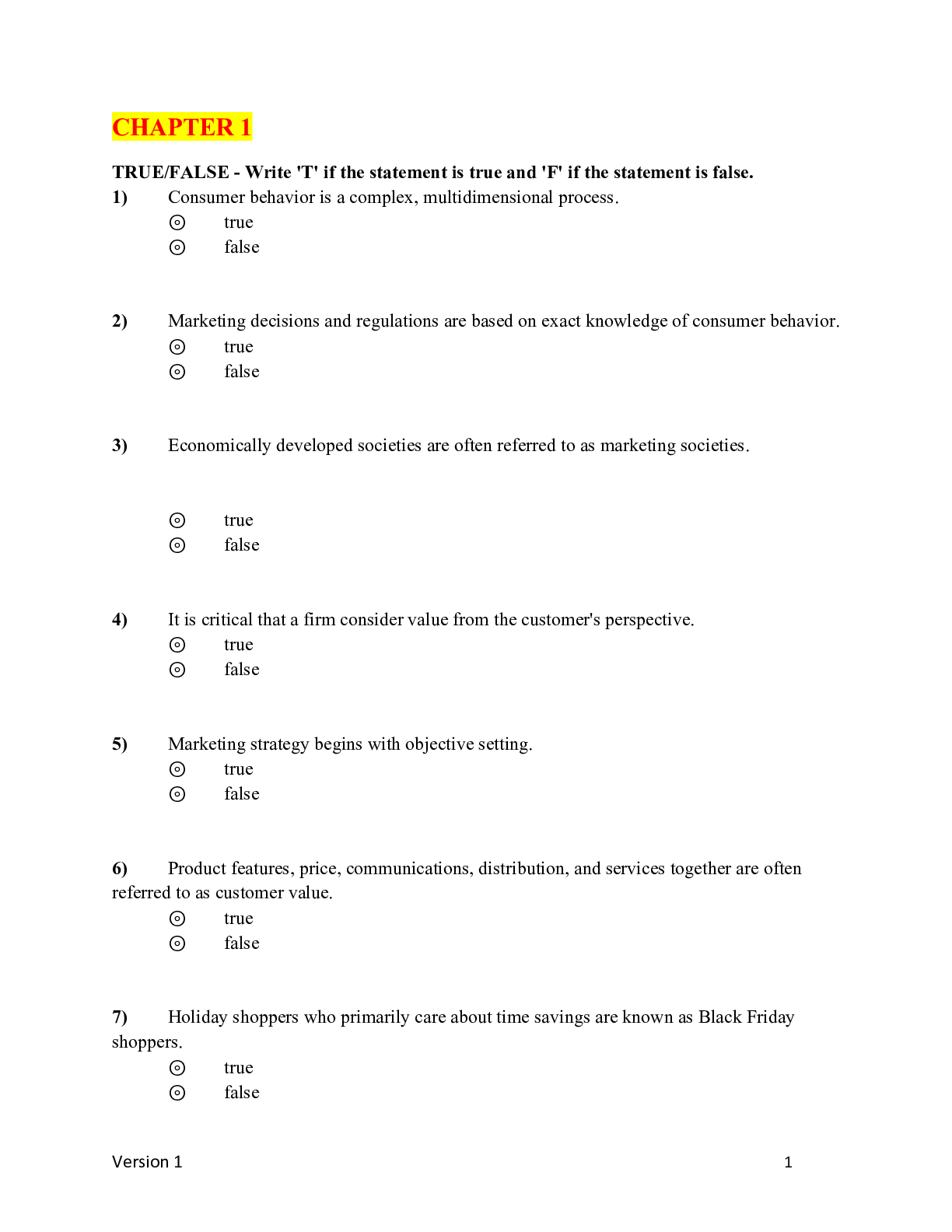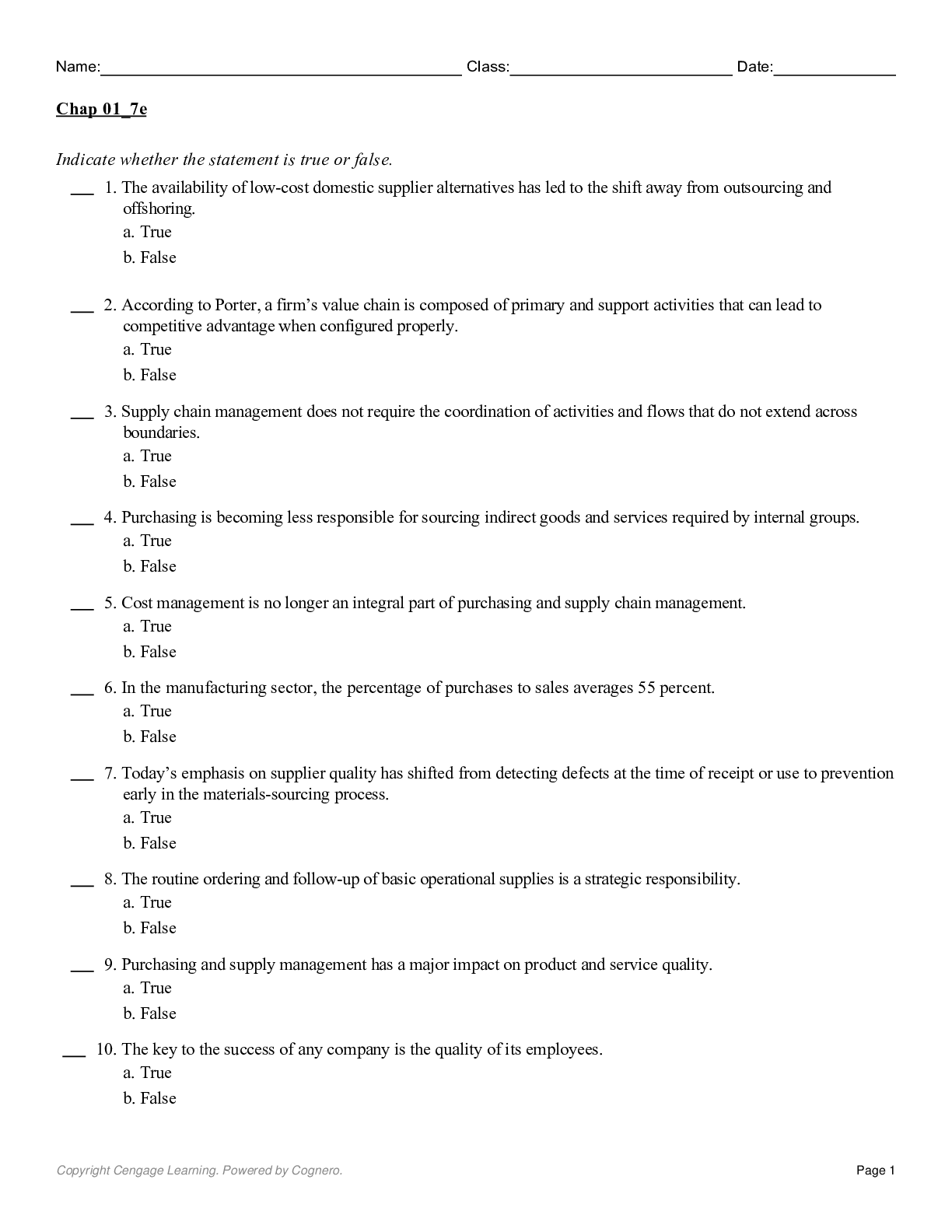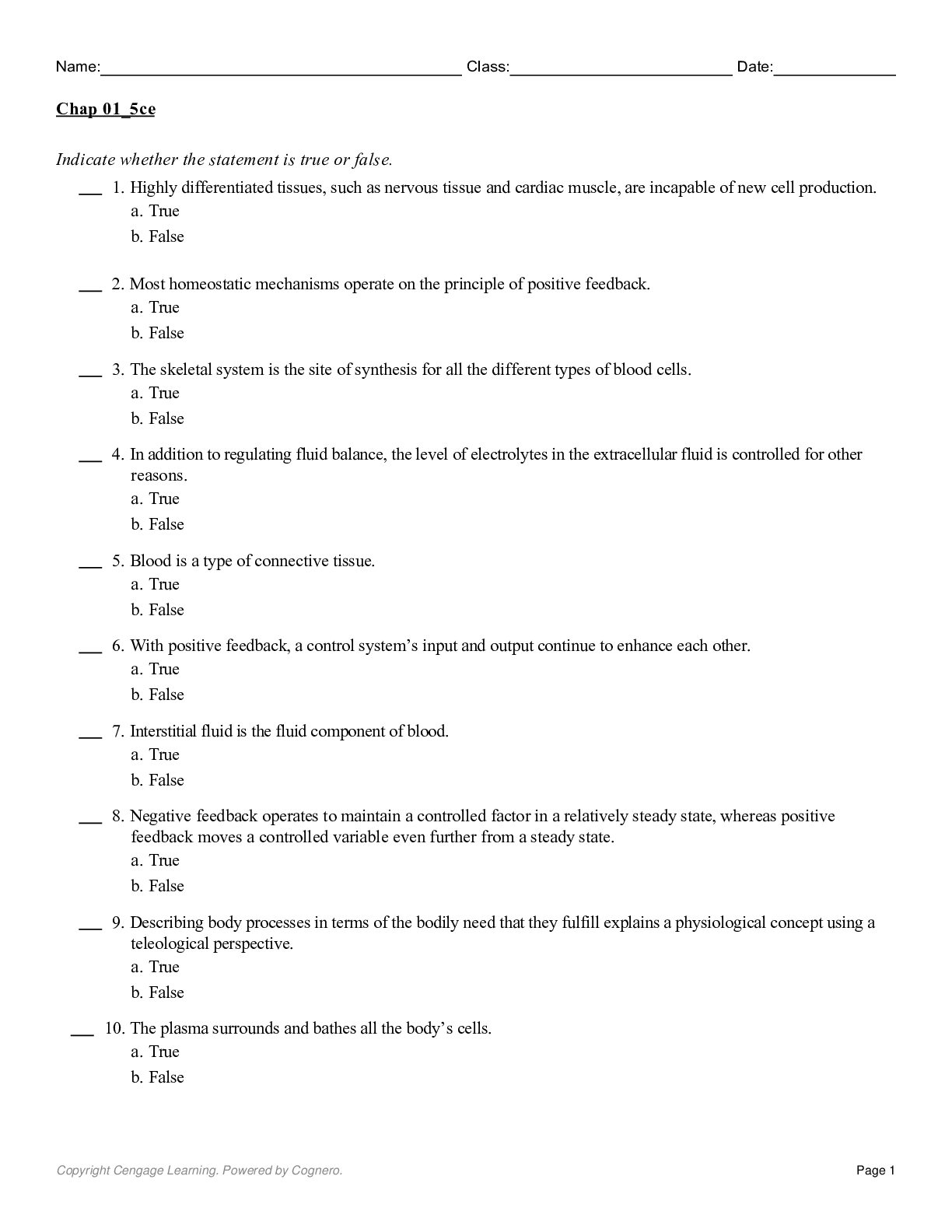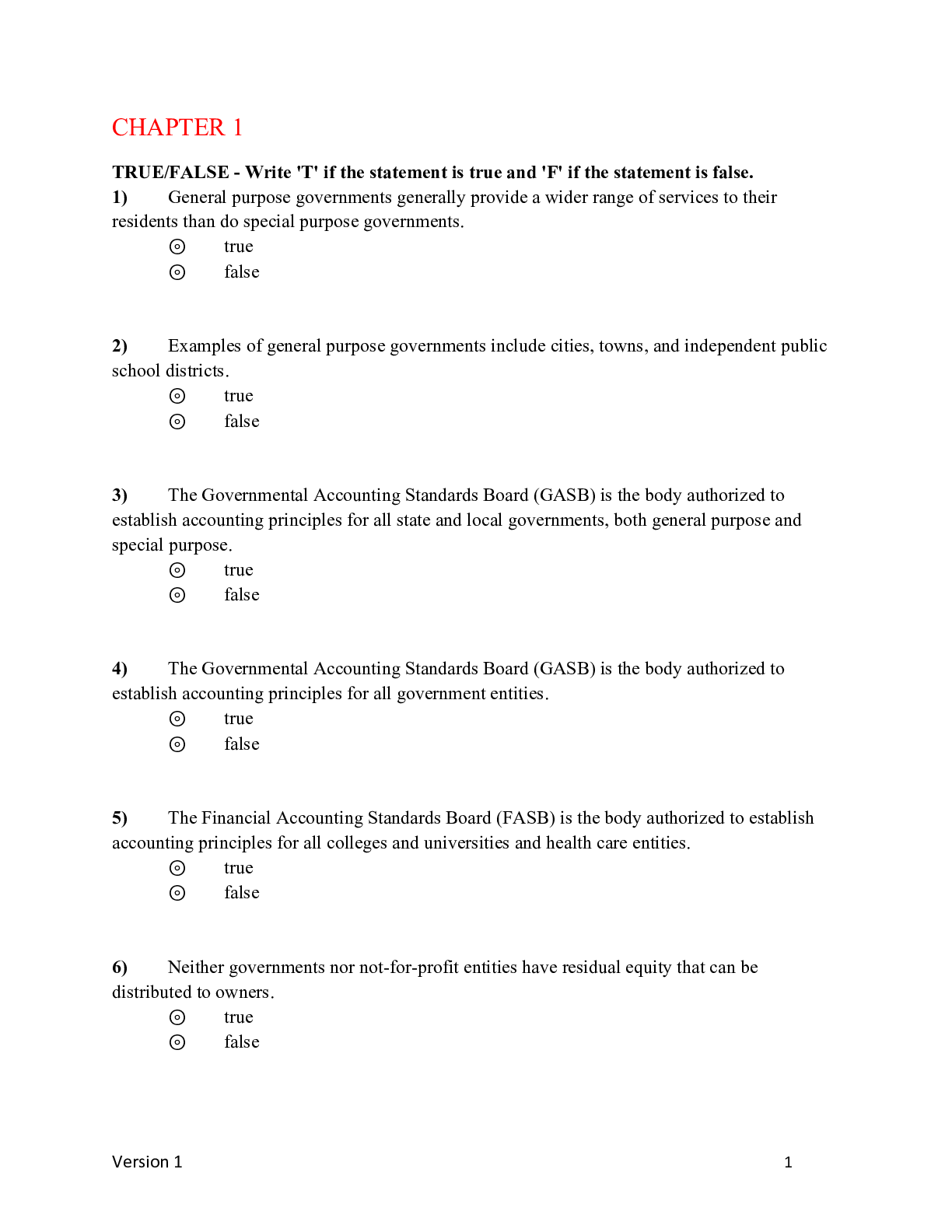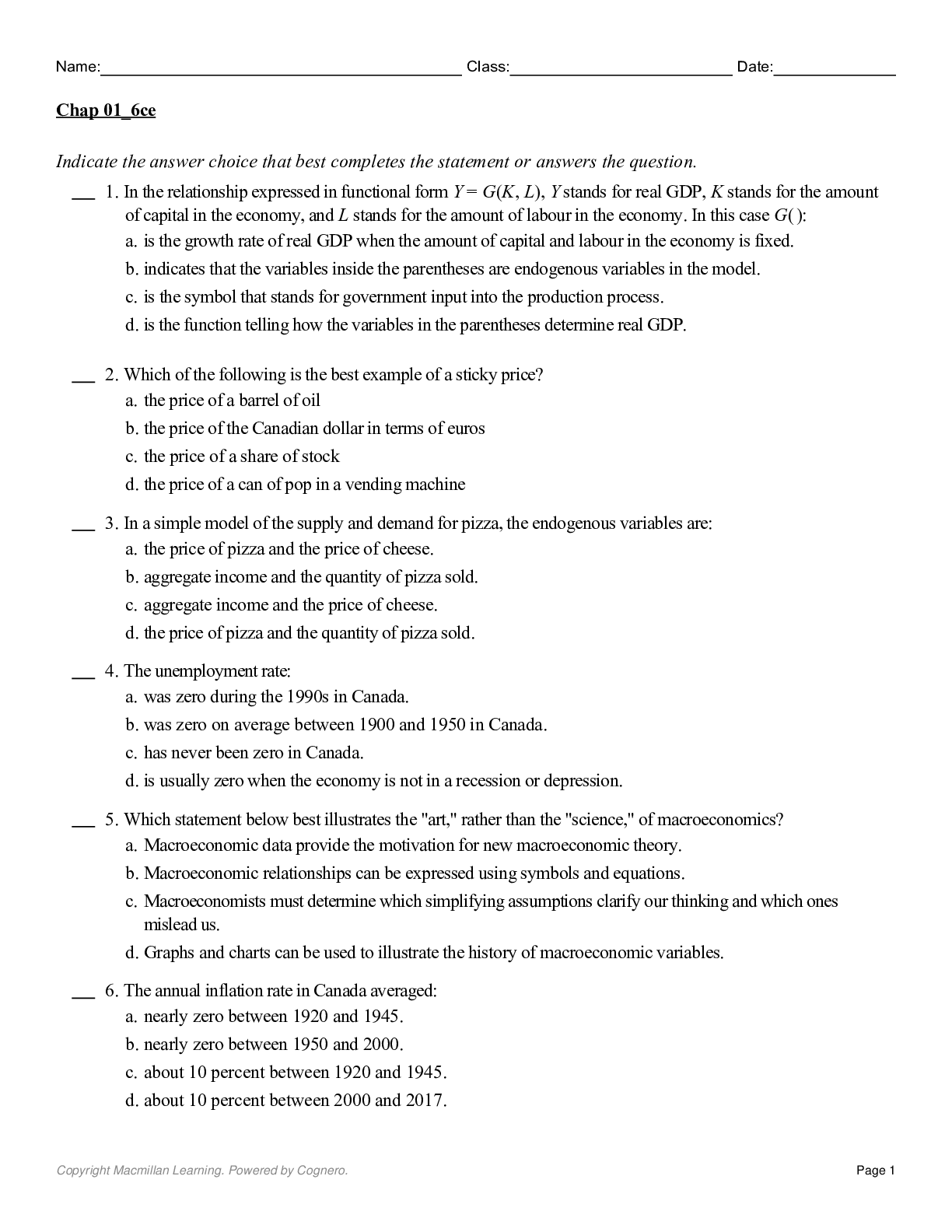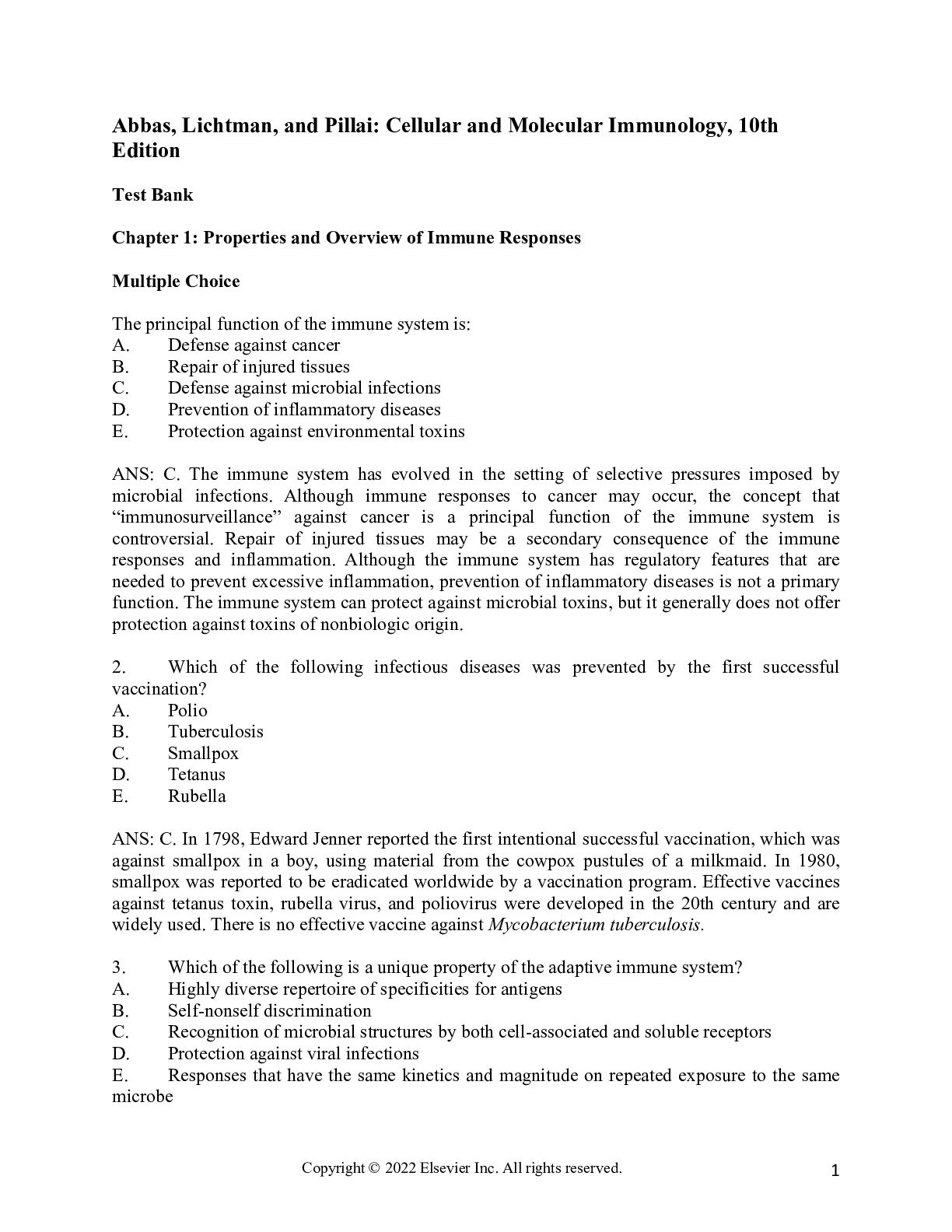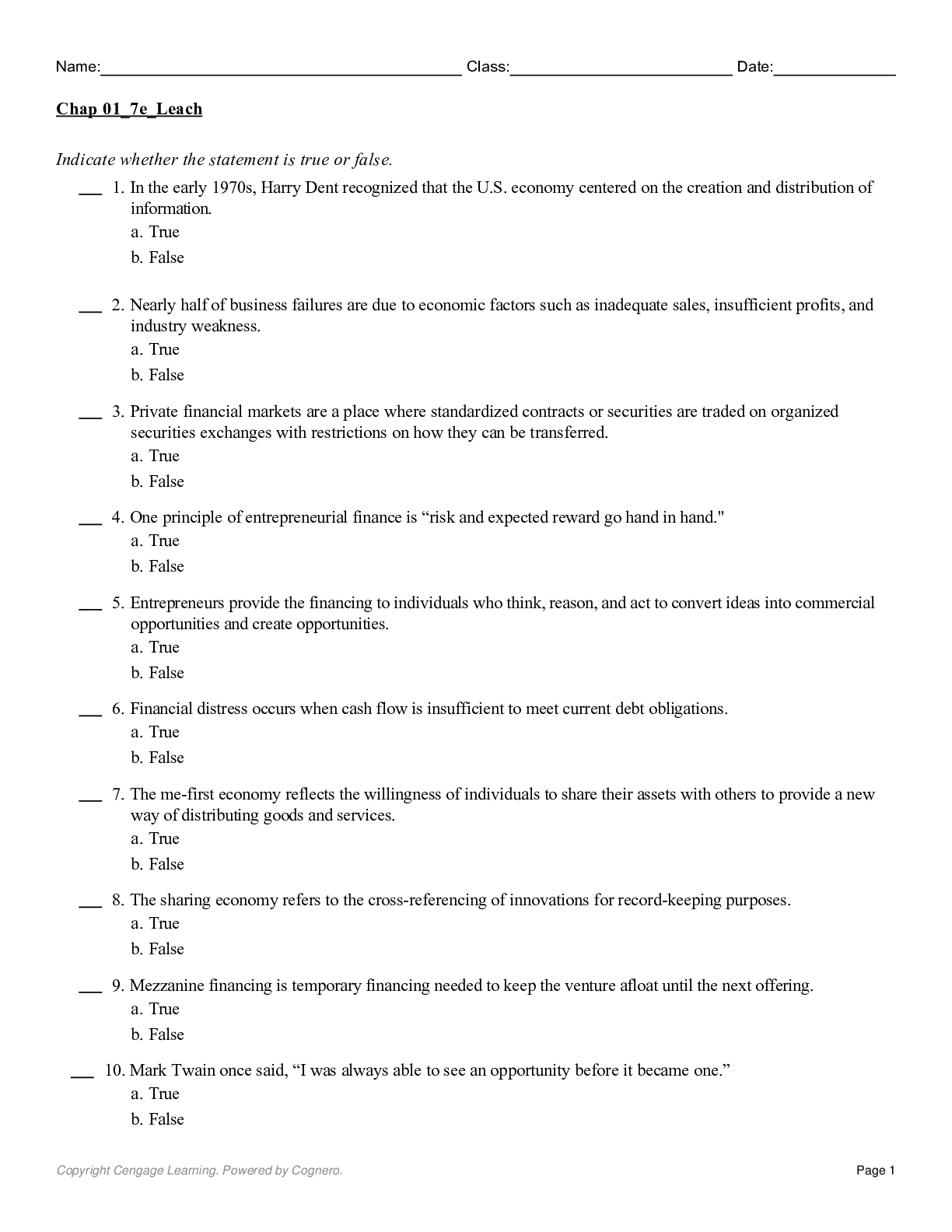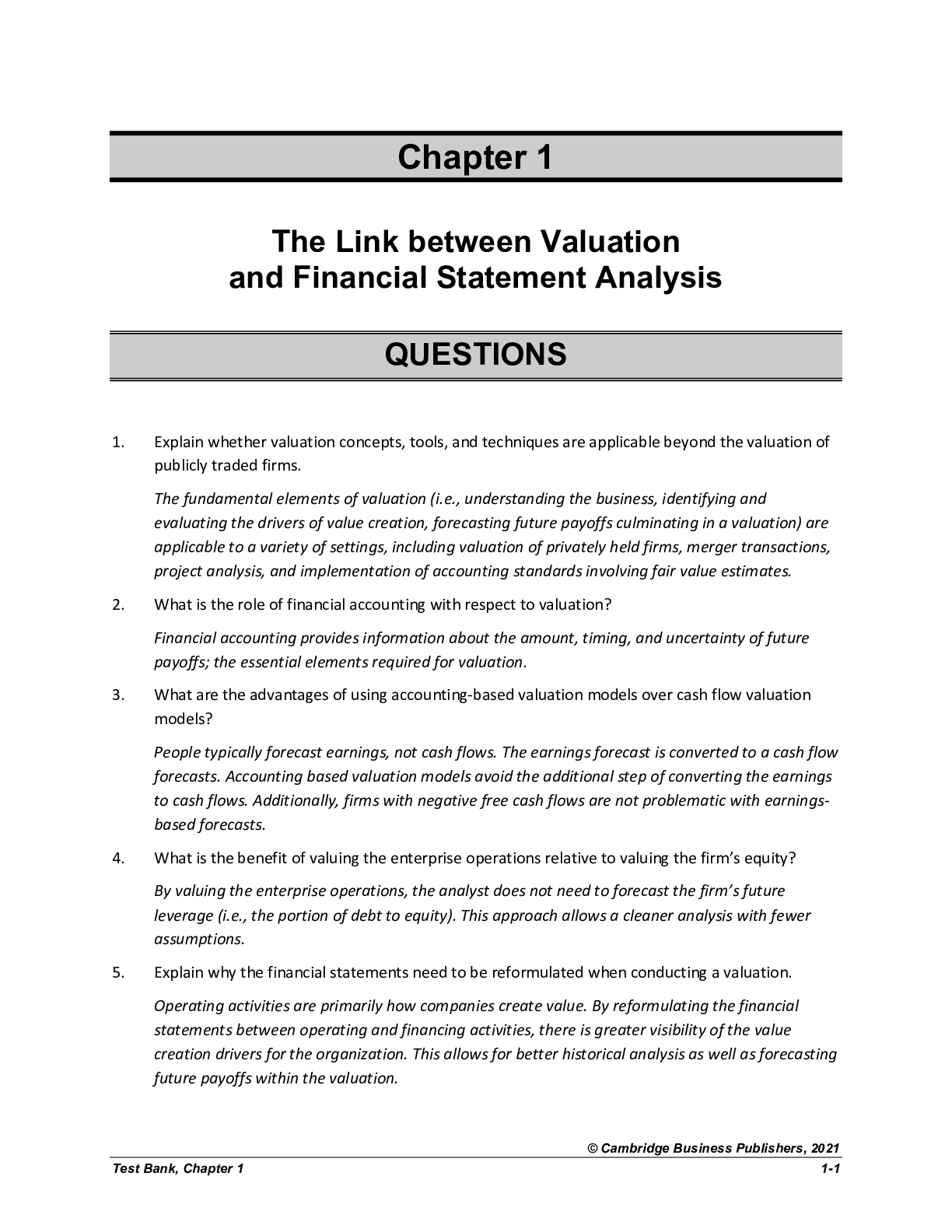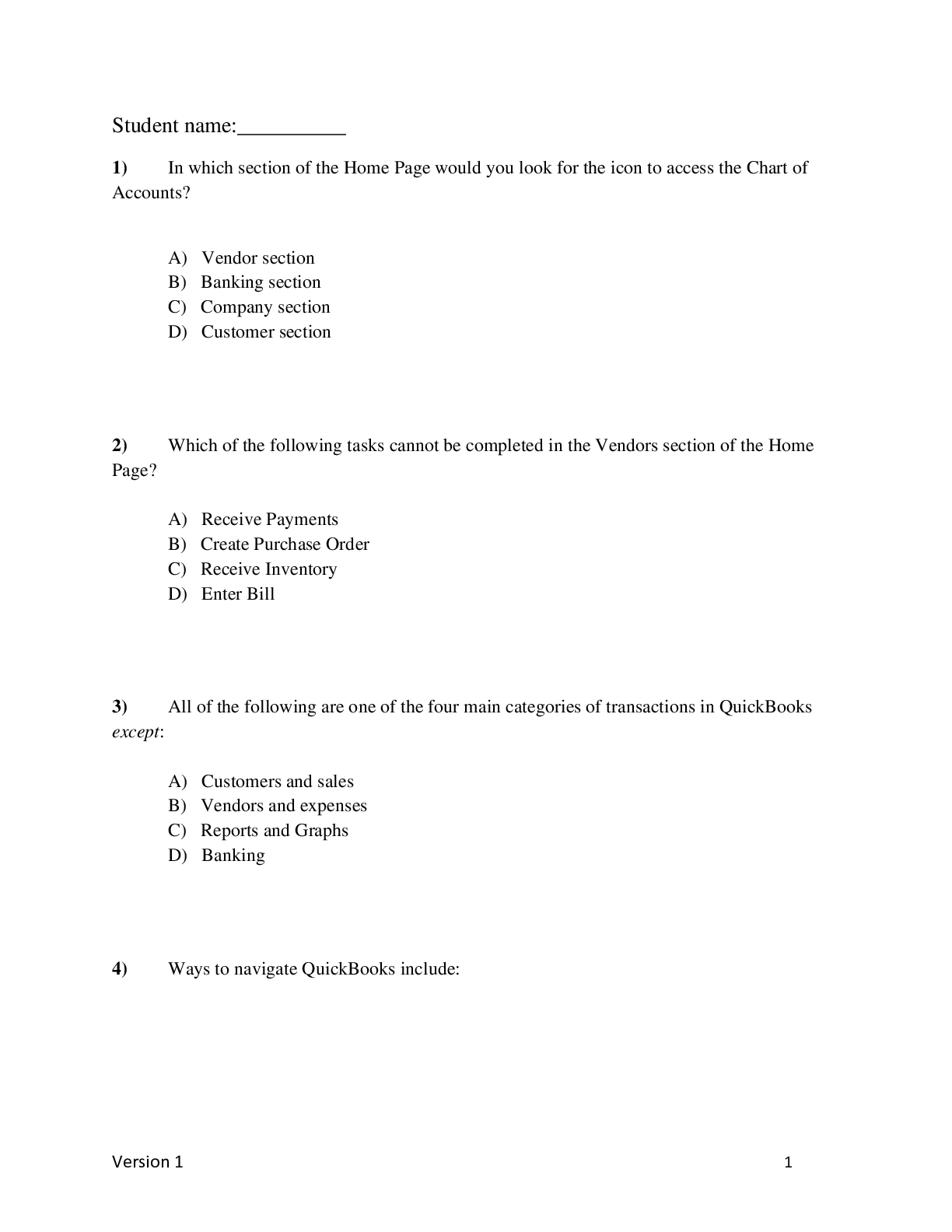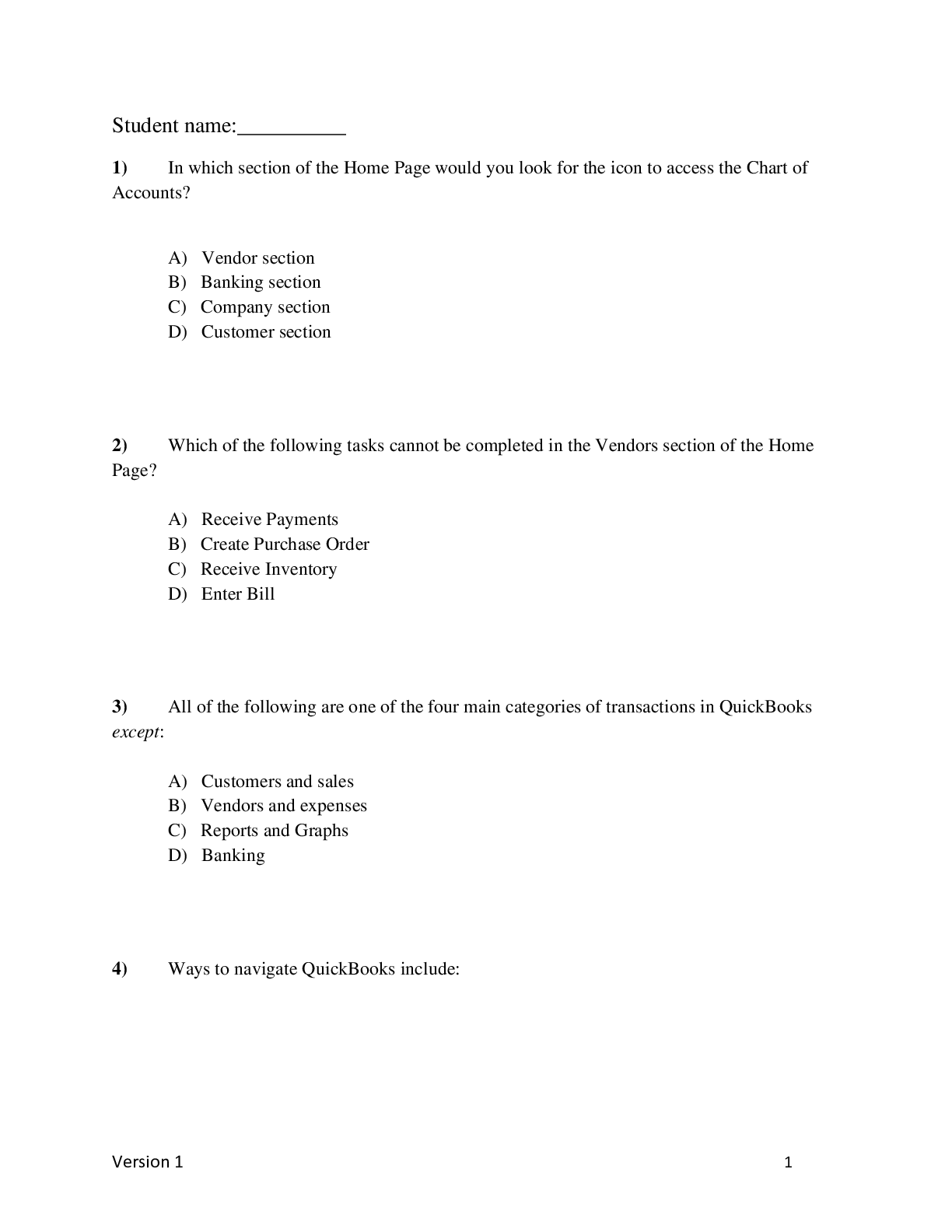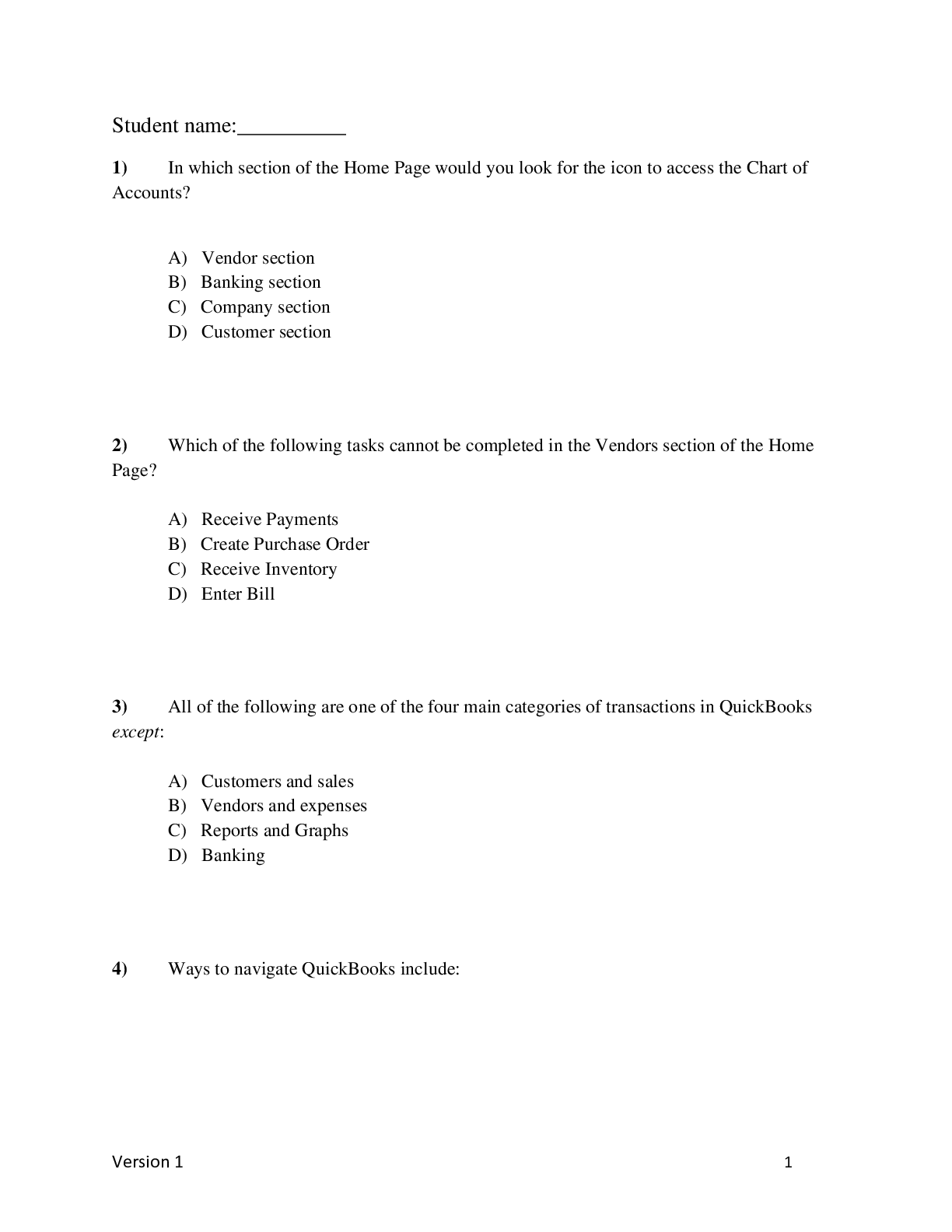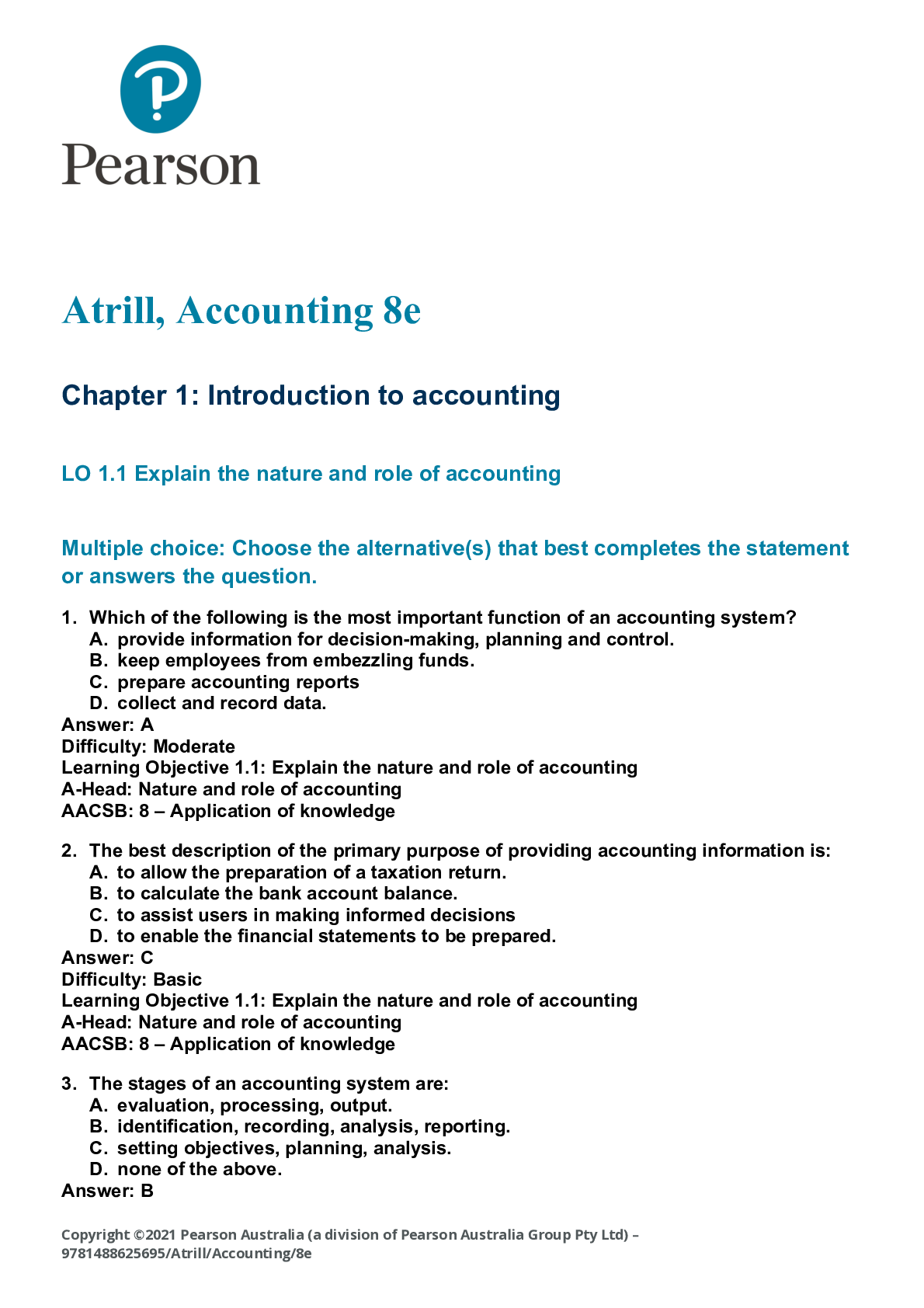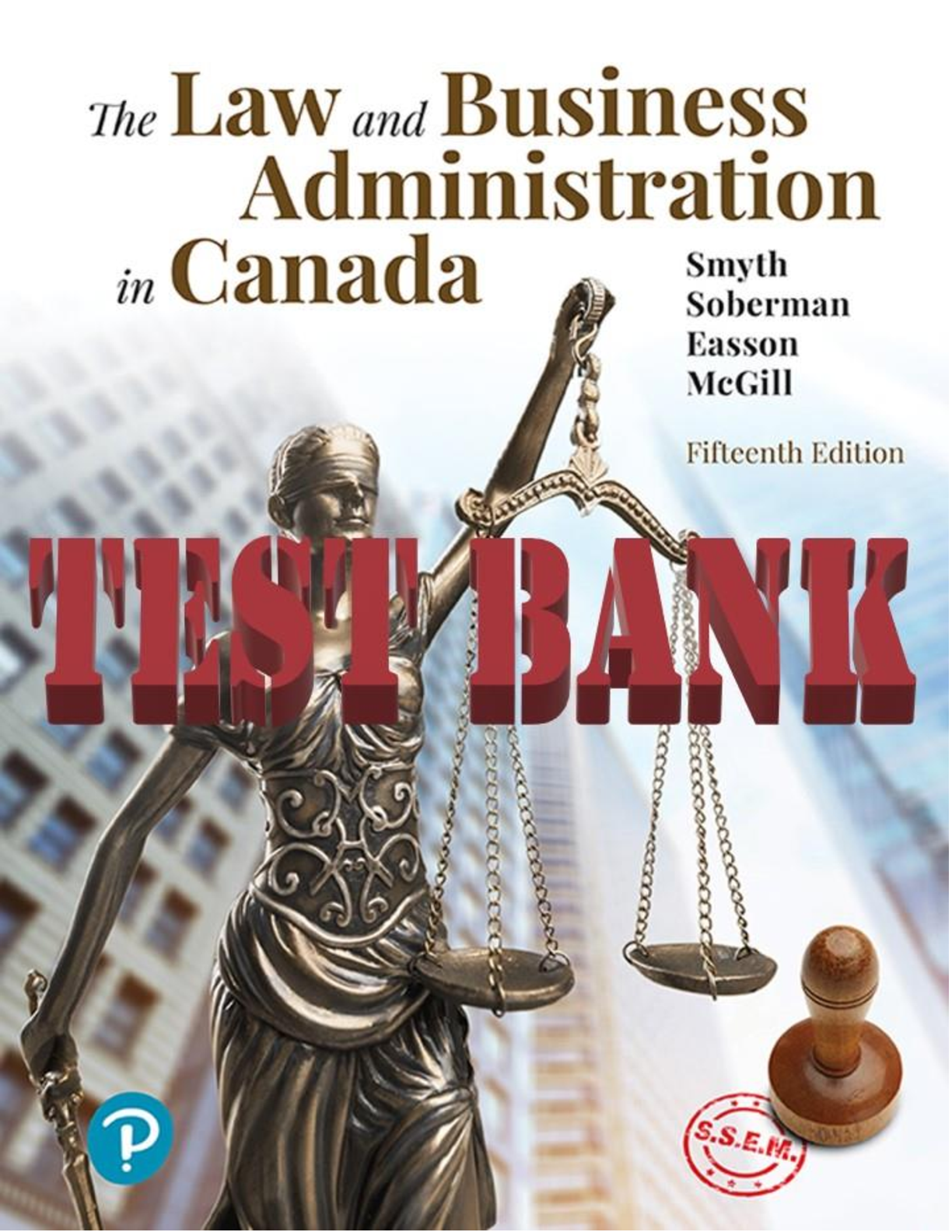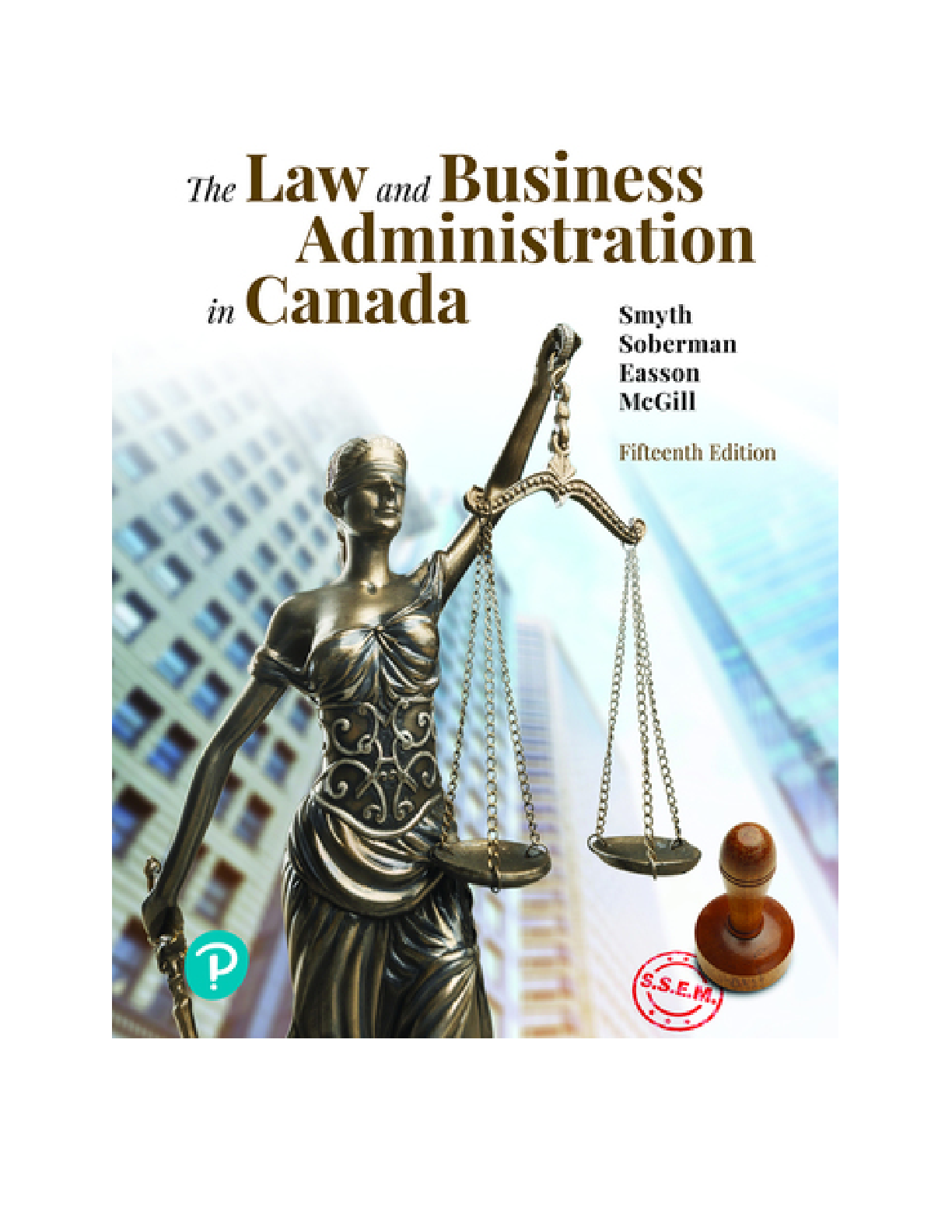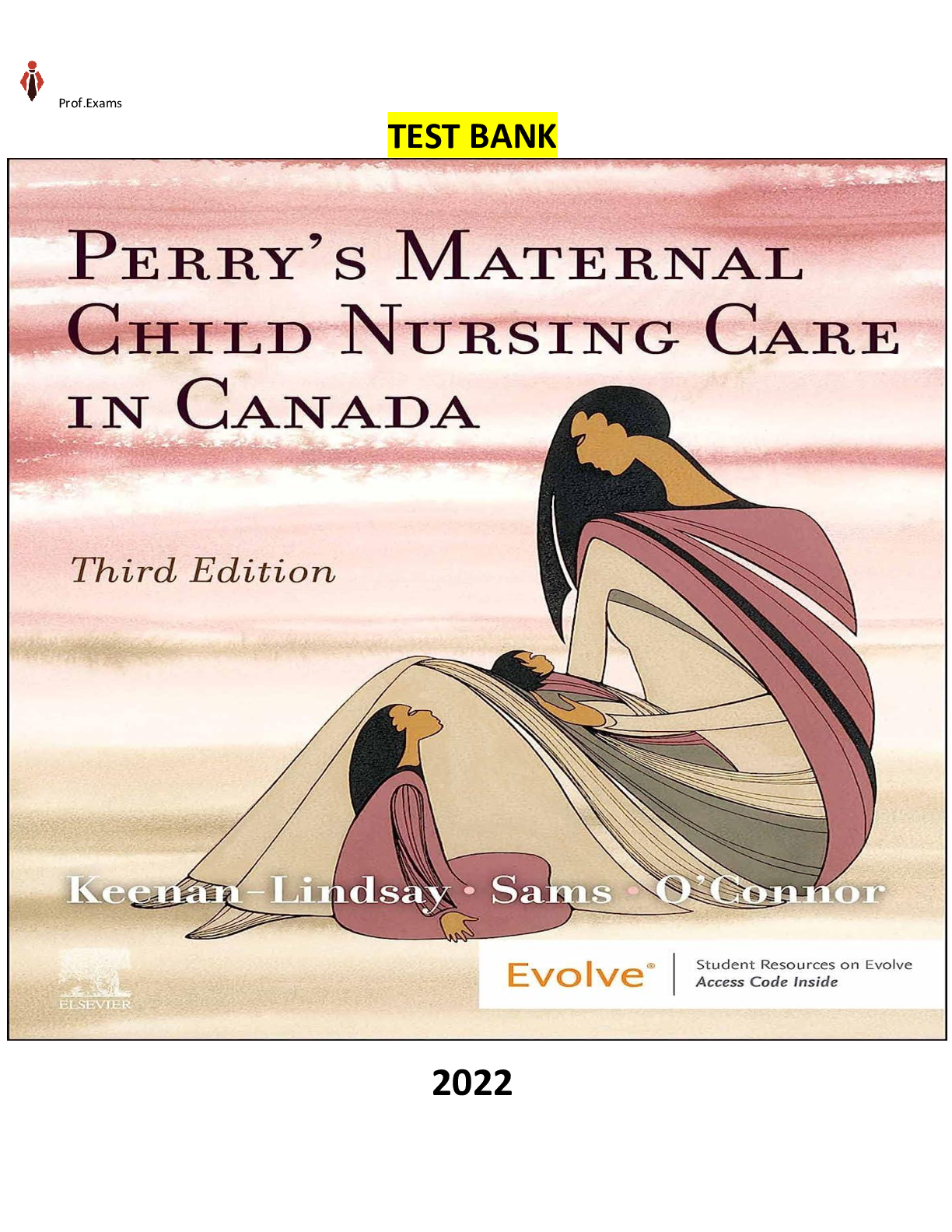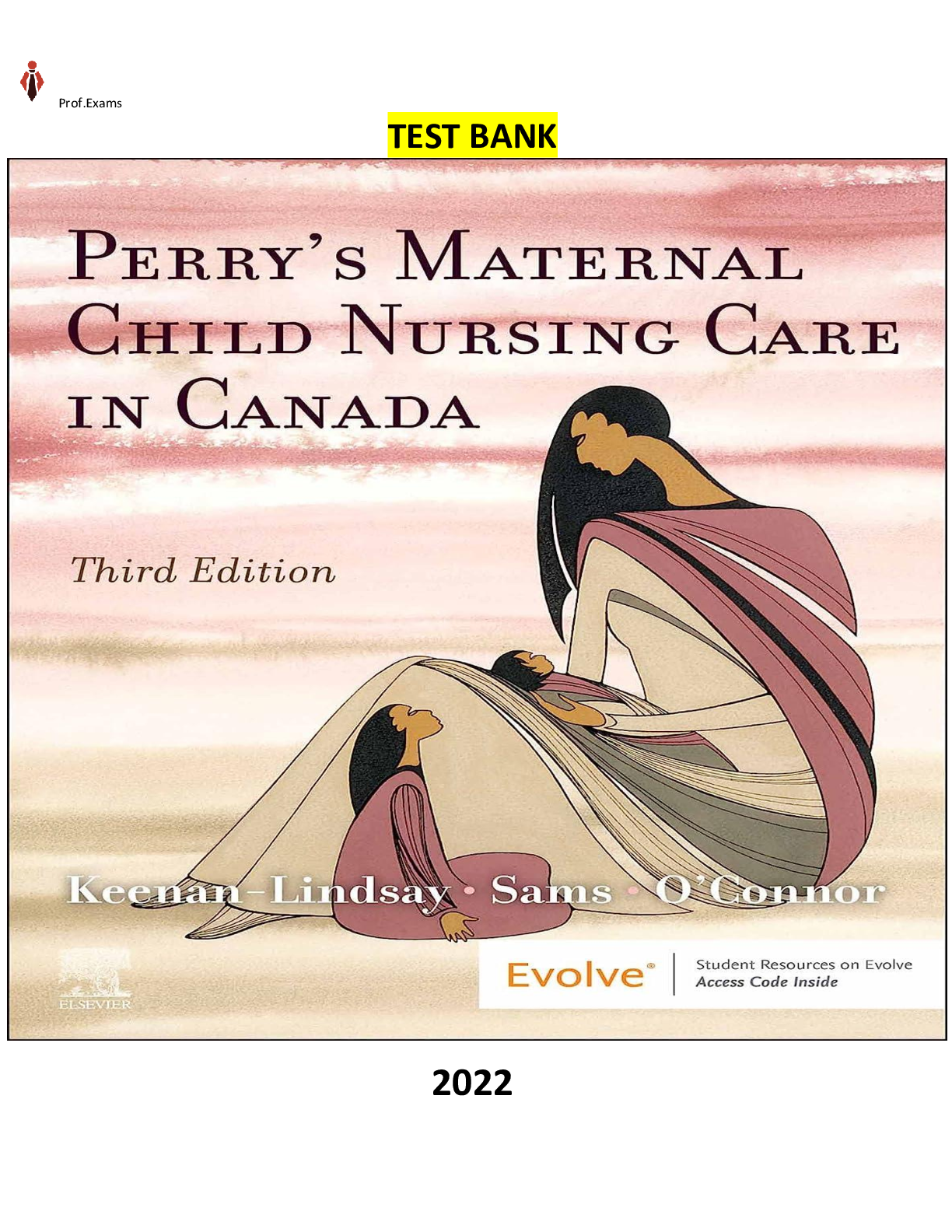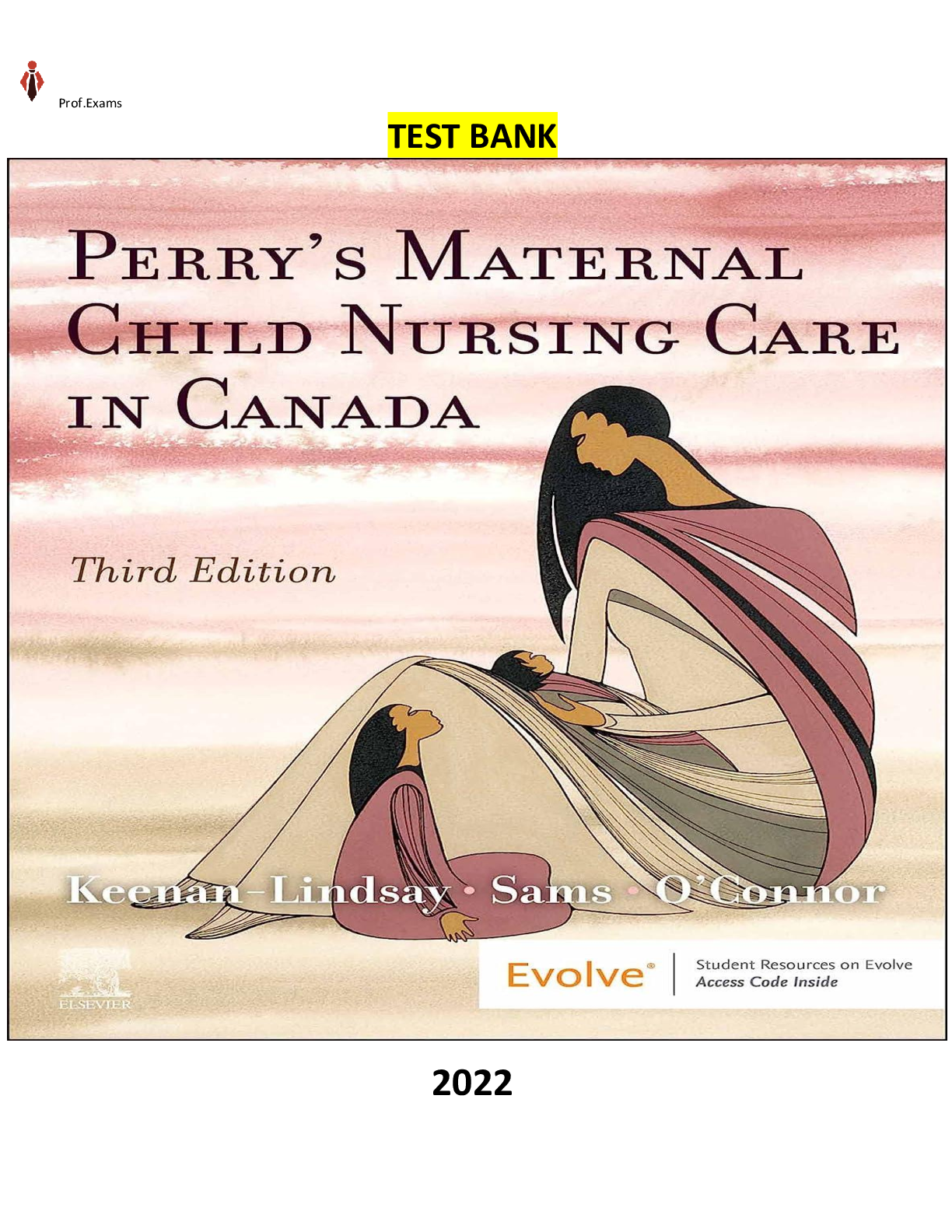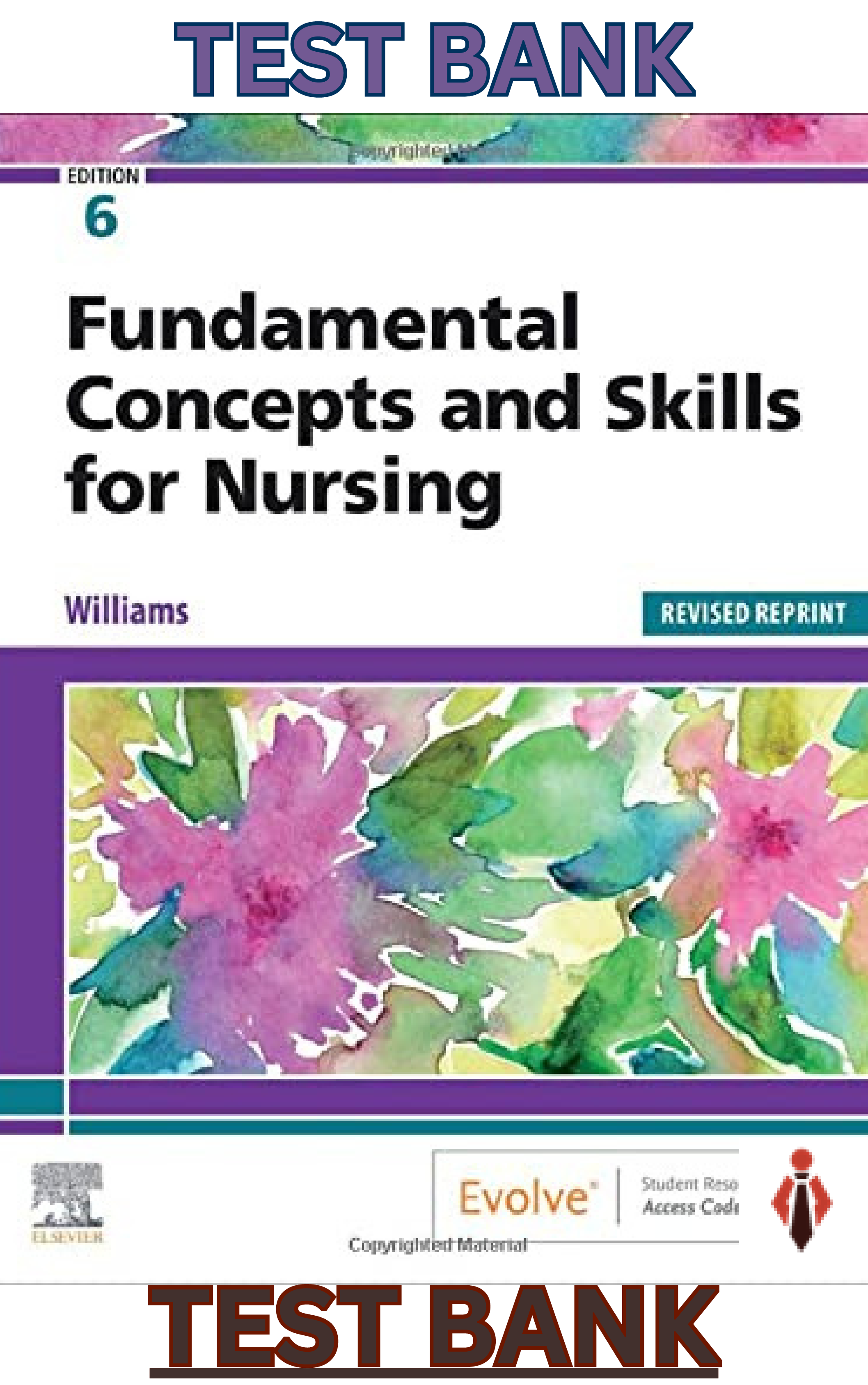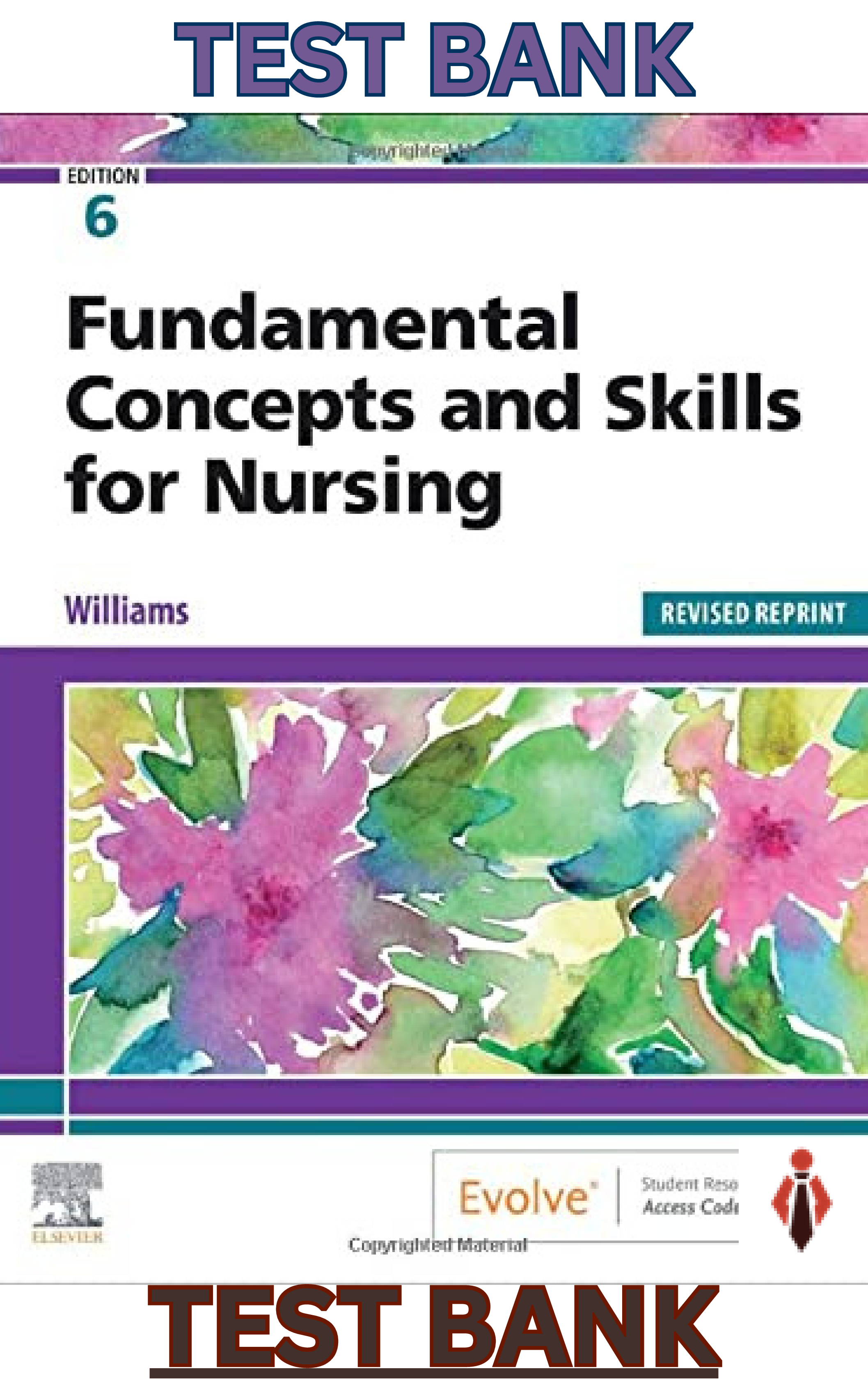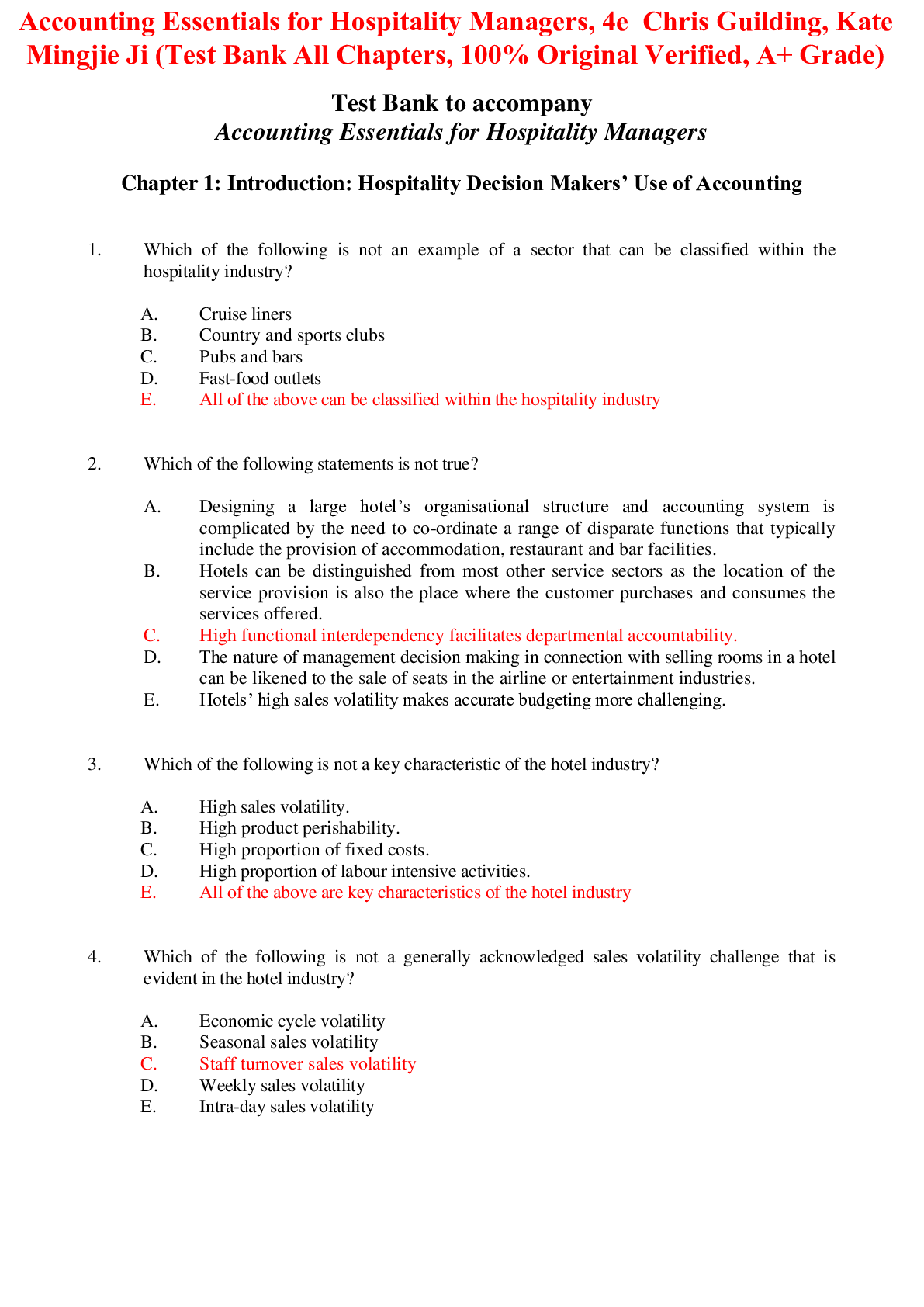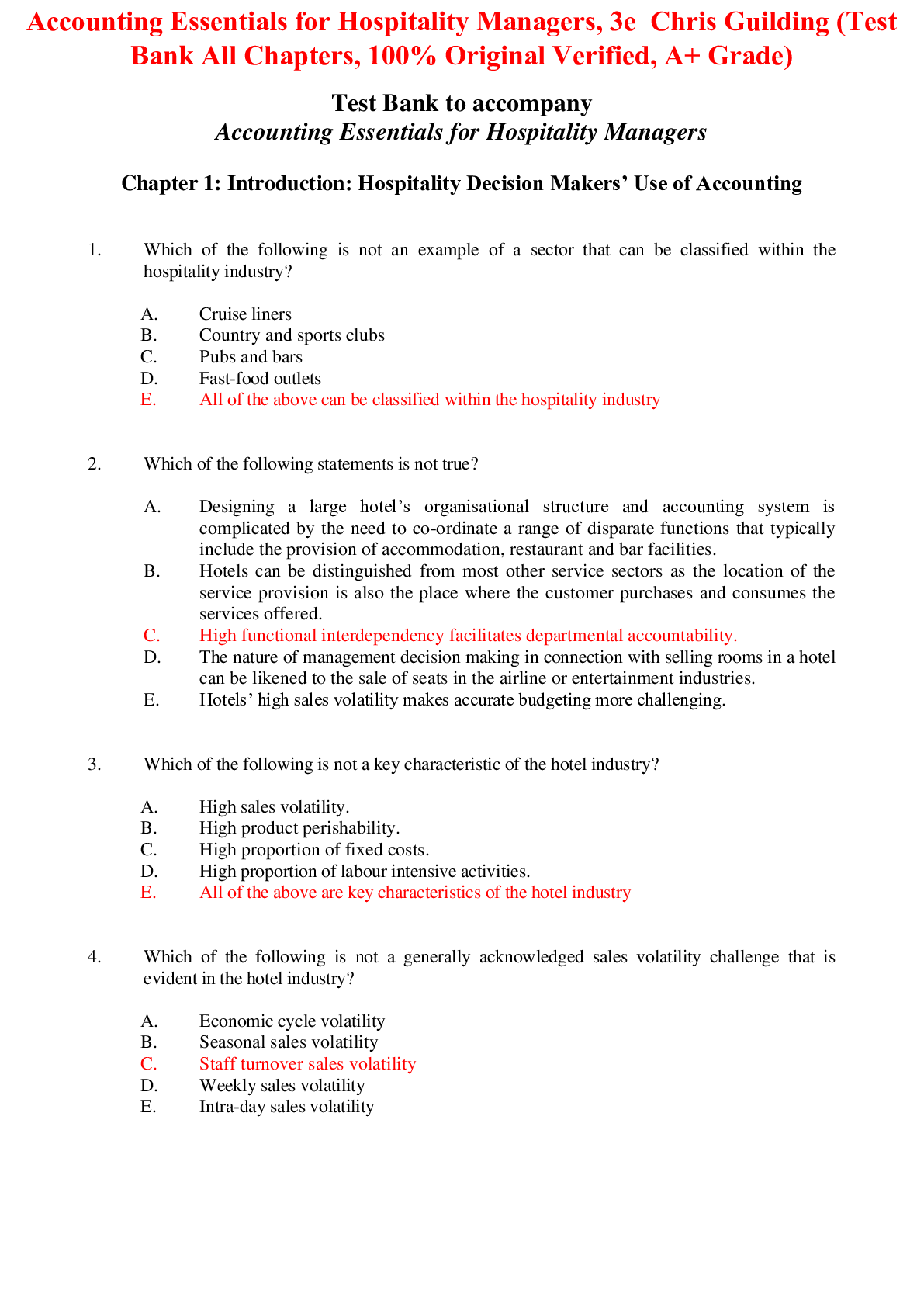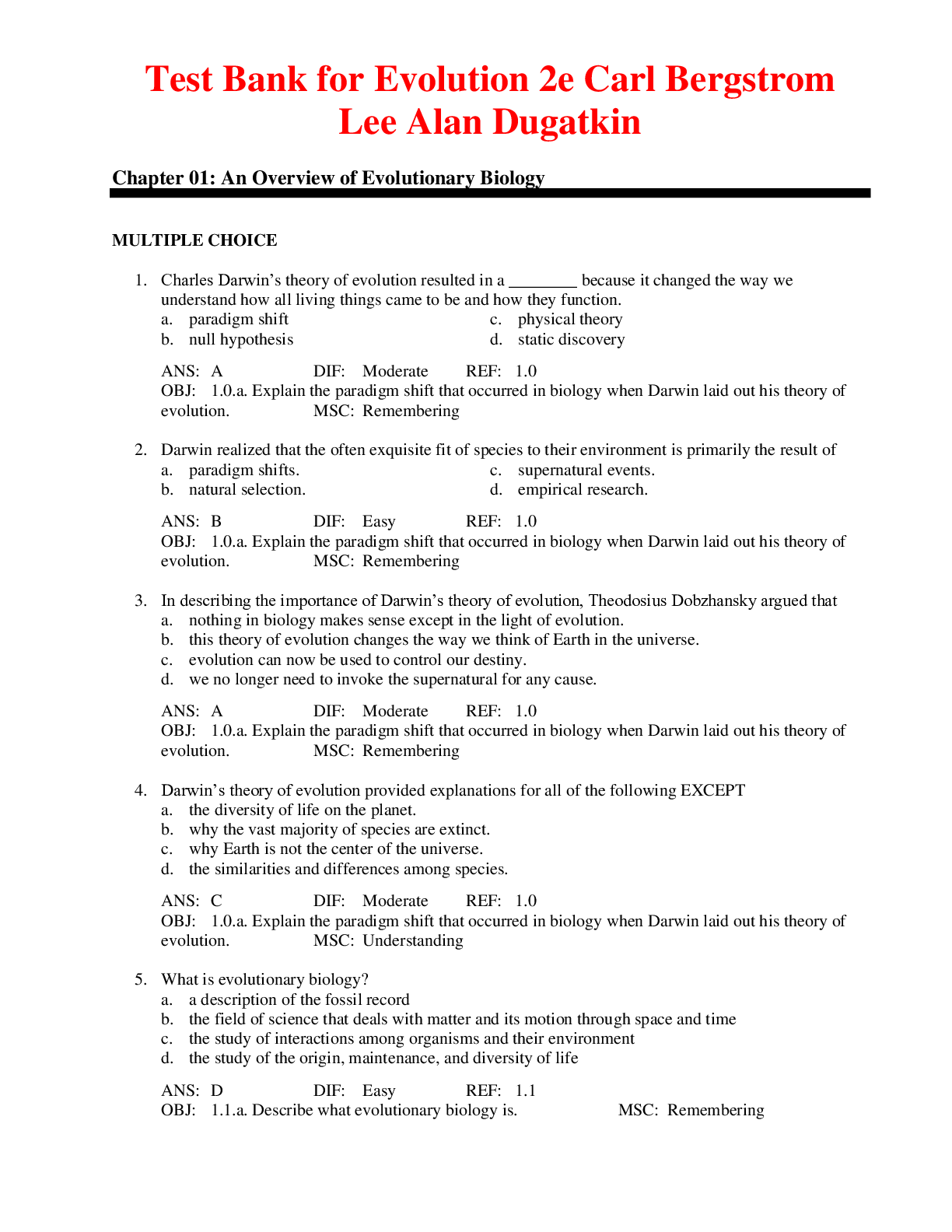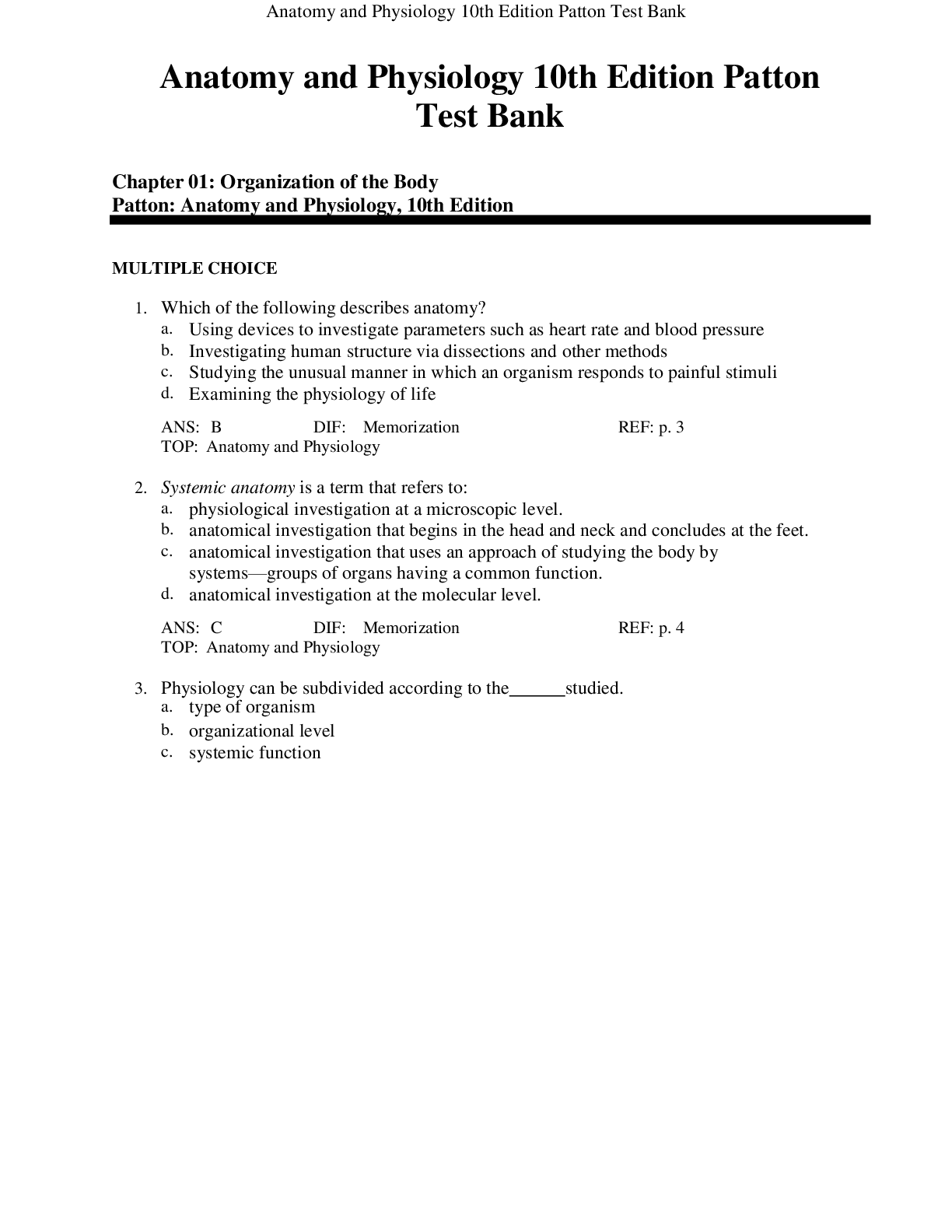Business Law > TEST BANK > The Law and Business Administration in Canada, 15E by Smyth Test Bank (All)
The Law and Business Administration in Canada, 15E by Smyth Test Bank
Document Content and Description Below
Test Bank for The Law and Business Administration in Canada, 15E, 15th Canadian Edition by J.E. Smyth,Dan Soberman,Alex Easson,Shelley McGill TEST BANK ISBN-13: 9780135353721 Full chapters included ... Part 1 The Law in Its Social and Business Context 1 Law, Society, and Business The Role of Law How Is Law Defined? How Is Law Linked to Morals and Ethics? Is It Ever Right to Break the Law? How Does Law Influence Behaviour? Law and Business The Significance of Law for the Business Environment Law and International Business Legal Risk Management Developing a Legal Risk Management Plan Strategies to Manage Legal Risks The Legal Profession Business and the Legal Profession Law and Business Ethics Business Ethics Codes of Conduct Who Makes Law? The Courts and Legislation Federalism and the Constitution The Charter of Rights and Freedoms The Rights and Freedoms Protected by the Charter The Significance of the Charter for Business Challenging the Application of a Statute Questions for Review 2 The Machinery of Justice Classifying Law Who Makes Law? Two Legal Systems: Civil Law and Common Law Regions of the World under Each System The Need for Consistency and Predictability Common Law: The Theory of Precedent Certainty Versus Flexibility Accommodating Change The Sources of Law Legislation: Government Made Law Case Law: Judge-Made Law The System of Courts The Courts of First Instance—Trial Courts The Court of Appeal Final Court of Appeal—The Supreme Court The System of Courts in Canada The Provincial Court System The Federal Court System The Supreme Court of Canada Procedural Law: Using the Courts Who May Sue? Standing to Sue Class Actions Procedure before Trial The Trial Judgment Appeals Costs The Economics of Civil Litigation Contingent Fees Settlement Out of Court Alternative Dispute Resolution Strategies to Manage the Legal Risks Questions for Review Cases and Problems 3 Government Regulation of Business The Legal Framework for Doing Business in Canada Challenging Government Regulation of Business Jurisdiction over “Business Activities” under the Constitution Business Regulations that Offend the Charter Regulation Improperly Applied in the Circumstances Competition The Competition Act Conspiracies Monopolizing Mergers Consumer Protection Why Is Consumer Protection Legislation Necessary? Principal Types of Consumer Legislation Environmental Protection The Legislative Framework Environmental Impact Assessment Review Enforcement and Liability Strategies to Manage the Legal Risks Questions for Review Cases and Problems Part 2 Torts 4 The Law of Torts The Development of Tort Law The Basis for Liability Fault Strict Liability Public Policy Vicarious Liability Intentional Torts Assault and Battery Nuisance False Imprisonment and Malicious Prosecution Defamation Other Intentional Torts Related to Business Unintentional Torts Negligence Elements of Negligence Defences to Negligence: The Plaintiff’s Own Conduct The Relevance of Insurance Product Liability Inherently Dangerous Products Occupier’s Liability Remedies Strategies to Manage the Legal Risks Questions for Review Cases and Problems 5 Professional Liability: The Legal Challenges Professional Liability: The Challenge Liability of Professionals Contracts Fiduciary Duty Tort Liability Statutory Liability Choosing a Cause of Action Tort Liability for Inaccurate Statements Fraudulent Misrepresentation Negligent Misrepresentation Proving Negligent Misrepresentation The Duty of Care—Special Relationship Accuracy of the Statement The Standard of Care for Professionals Reliance and Detriment The Role of Professional Organizations Responsibilities and Powers Codes of Conduct Discipline Conflict of Duty toward Clients, the Profession, and the Courts Multi-Disciplinary Partnerships Strategies to Manage the Legal Risks Questions for Review Cases and Problems Part 3 Contracts 6 Formation of a Contract: Offer and Acceptance The Role of Contract Law The Nature of a Contract The Nature of an Offer The Communication of an Offer Written Offers Standard Form Contracts: Their Risks and Benefits Notice of Terms The Lapse and Revocation of an Offer Lapse Revocation Options Rejection and Counter-offer by the Offeree The Elements of Acceptance Positive and Unconditional Communication to the Offeror The Moment of Formation Transactions Between Parties at a Distance from Each Other Method of Acceptance Methods of Revocation Determining the Jurisdiction Where a Contract Is Made Unilateral and Bilateral Contracts Bilateral: Offer of a Promise for a Promise Unilateral: Offer of a Promise for an Act Formation of Internet Contracts Uncertainty in the Wording of an Offer Strategies to Manage the Legal Risks Questions for Review Cases and Problems 7 Formation of a Contract: Consideration and Intention The Meaning of Consideration Gratuitous Promises Adequacy of Consideration Motive Contrasted with Consideration: Past Consideration Relation Between Existing Legal Duty and Consideration Gratuitous Reduction of a Debt Equitable Estoppel Estoppel Based on Fact Injurious Reliance The Effect of a Request for Goods or Services The Use of a Seal Intention to Create Legal Relations Strategies to Manage the Legal Risks Questions for Review Cases and Problems 8 Formation of a Contract: Capacity to Contract and Legality of Object The Burden of Proving Essential Elements of a Contract The Meaning of Capacity to Contract Limited Capacity Minors (or Infants) Other Persons of Diminished Contractual Capacity Corporations Labour Unions, Associations, and Other Organizations Aboriginal Peoples The Role of Legality in the Formation of a Contract The Difference Between Void and Illegal Contracts Contracts Affected by Statute Significance of the Wording of a Statute Examples of Contracts Void by Statute Examples of Statutes Affecting Public Policy Examples of Agreements Illegal by Statute Examples of Agreements Made Legal by Statute Contracts Illegal by the Common Law and Public Policy The Common Law Public Policy Agreements in Restraint of Trade Strategies to Manage the Legal Risks Questions for Review Cases and Problems 9 Contract Issues: Mistake and Misrepresentation Setting Aside a Contract The Narrow Meaning of Mistake Void and Voidable Contracts Mistakes About the Terms Words Used Inadvertently Errors in Recording an Agreement Misunderstandings About the Meanings of Words Mistakes About the Subject Matter Mistake About the Existence of the Subject Matter of a Contract Mistake About the Value of the Subject Matter Mistakes About the Identity of a Party to a Contract Mistakes About the Nature of a Signed Document Non Est Factum Misrepresentation Contract Versus Tort Consequences of Misrepresentation in Contracts Misrepresentation by Silence or Omission Undue Influence Burden of Proof Arrangements Involving Spouses Importance of Independent Legal Advice Consumer Protection Duress Strategies to Manage the Legal Risks Questions for Review Cases and Problems 10 Writing and Interpretation The Distinction Between Substance and Form The Benefits of a Written Record Legislation Dealing with Writing The Statute of Frauds The Types of Contracts Covered by the Statute of Frauds Requirements for a Written Memorandum Consequences for Contracts Within Its Scope What Constitutes a Sale of Goods for the Purposes of the Writing Requirement? Evidence That Satisfies the Act When Both Acts Apply Consumer Protection Legislation The Interpretation of Express Terms The Goal of the Courts: To Give Validity to Contracts Legal Principles of Interpretation General Approach to Interpretation Special Usage of Words Conflicting Testimony and Credibility Special Contracts or Clauses The Parol Evidence Rule The Meaning of Parol Evidence The Meaning of the Parol Evidence Rule Exceptions to the Parol Evidence Rule Implied Terms as a Method of Interpretation Terms Established by Custom or Statute Reasonable Expectation of the Parties Strategies to Manage the Legal Risks Questions for Review Cases and Problems 11 Privity of Contract and the Assignment of Contractual Rights Privity of Contract Scope of Contractual Rights and Duties Comparison with Rights and Duties in Tort Tort Liability and Vicarious Performance Exceptions to the Privity of Contract Rule Trusts Insurance The Undisclosed Principal Contracts Concerning Land Express Language in the Contract Assignment of Rights The Nature of an Assignment The Importance of Assignments The Role of Equity Equitable Assignments Assignment of Part of a Debt Statutory Assignments Reform The Requirements of the Statute Notice to the Promisor The Effect of Notice on the Promisor The Effect of Notice from Multiple Assignees The Assignee’s Title An Assignee “Takes Subject to the Equities” The Right to Set Off Assignments by Operation of Law Death Bankruptcy Negotiable Instruments Their Nature and Uses Negotiability Compared with Assignability Commercial Importance of Negotiability Currency Strategies to Manage the Legal Risks Questions for Review Cases and Problems 12 The Discharge of Contracts The Ways in Which a Contract May Be Discharged Discharge by Performance The Nature of Discharge by Performance Tender of Performance Discharge by Agreement Waiver Substituted Agreement A Contract Provides for Its Own Dissolution Discharge by Frustration Doctrine of Frustration Self-Induced Frustration The Effect of Frustration Discharge by Operation of Law Strategies to Manage the Legal Risks Questions for Review Cases and Problems 13 Breach of Contract and Remedies Implications of Breach How Breach May Occur Express Repudiation One Party Renders Performance Impossible Failure of Performance Degree of Failure Doctrine of Substantial Performance Duty of Honesty in Performance Overperformance Exemption Clauses Purpose Analytical Approach Types of Remedies Damages The Purpose of an Award of Damages Prerequisites for an Award of Damages The Measurement of Damages Liquidated Damages Nominal Damages Types of Damages Expectation Damages Consequential Damages General Damages Reliance Damages Punitive Damages Challenges in Measuring Damages Mental Anguish Cost of Performance Versus Economic Loss Equitable Remedies Reasons for the Intervention of Equity Prerequisites for an Equitable Remedy Specific Performance Injunction Rescission Quantum Meruit Methods of Enforcing Judgments Strategies to Manage the Legal Risks Questions for Review Cases and Problems Part 4 Special Types of Contracts 14 Sale of Goods and Consumer Contracts The Sale of Goods Act History of the Sale of Goods Act Contracts of Sale Goods Ownership and Possession Terms in a Contract of Sale The Caveat Emptor Principle Statutory Protection for the Buyer: Implied Terms Exemption Clauses Payment Delivery Risk of Loss before Delivery Title to Goods Who May Pass Title? When Does Title Pass? Bills of Lading Remedies of the Seller Lien Repossession Resale Damages for Non-Acceptance Action for the Price Retention of Deposit The Seller’s Liability Breach of a Term Wrongful Withholding or Disposition by the Seller Remedies of the Buyer Consumer Contracts Consumer Protection Business Sales Tactics Targeting Consumers Pressure Selling Unsolicited Goods Telemarketing Terms in Consumer Contracts Legislated Terms Exemption Clauses Repossession Arbitration and Class Actions Severance Financing Arrangements and Disclosure of the True Cost of Credit Consumer Remedies Strategies to Manage the Legal Risks Questions for Review Cases and Problems 15 Bailment and Leasing Bailment Definition Nature of Bailment Sub-Bailment Rights and Duties of a Bailee Liability under Contract and Tort The Standard of Care Rights and Remedies Lien The Right of Sale Special Types of Bailment Storage and Safekeeping Repairs and Work on a Chattel Transportation Innkeepers Pledge or Pawn Leasing Types of Chattel Lease Operating Leases Purchase Leases Security and Finance Leases Sale-and-Leaseback Reasons for Chattel Leasing Common Terms in Chattel Leases Duration Rent Insurance and Other Costs Payable by the Lessee Purchase Option Consent to Assignment (Sub-Bailment) Early Termination—Minimum Payment Implied Terms Rights of the Parties The Lessor The Lessee Strategies to Manage the Legal Risks Questions for Review Cases and Problems 16 Insurance and Guarantee Insurance and the Management of Legal Risk Insurance Terminology Regulation of Insurance Business Types of Insurance Insurance against Loss or Damage Insurance against Liability Comprehensive Insurance Special Aspects of Insurance Contracts Legality of Objects—Wrongful Act of the Insured Insurable Interest Formation of the Contract Renewal Interpreting Terms of the Contract Good Faith, Fairness, and Disclosure Subrogation Recovery Assignment Guarantee The Nature of a Guarantee Continuing Guarantee Consideration Discharge of Guarantee Rights of the Guarantor on Default Requirement of Writing Strategies to Manage the Legal Risks Questions for Review Cases and Problems 17 Agency and Franchising Defining Agency Creation of an Agency Relationship By Agreement Other Ways to Create an Agency Relationship Duties Owed by an Agent to the Principal Duty to Comply with the Agency Agreement Duty of Care Personal Performance Good Faith Duties Owed by the Principal to the Agent The Authority of the Agent Actual Authority Apparent Authority Ratification Rights and Liability of Principal and Agent The Principal Alone Is Liable on the Contract The Agent Alone Is Liable on the Contract Either the Principal or the Agent May Be Held Liable on the Contract Rights of the Undisclosed Principal Liability for Torts Breach of Warranty of Authority Terminating an Agency Relationship Franchising The Nature of Franchising Contents of a Typical Franchising Agreement Legal Relationships Created by Franchising Various Franchise Models Franchise Legislation Strategies to Manage the Legal Risks Questions for Review Cases and Problems 18 The Contract of Employment Development of Employment Law Relationship of Employer and Employee Compared with Agency Compared with Contractors Employment Relationship at Common Law The Employer’s Liability to Third Persons Liability in Contract Liability in Tort Notice of Termination of Individual Employment Contracts Express Term in the Contract Implied Term of Reasonable Notice Length of Reasonable Notice Dismissal without Notice Misconduct Disobedience Incompetence Illness Discovery of Cause Progressive Discipline Adverse Economic Conditions Wrongful Dismissal Damages Mitigation Reinstatement Employee Welfare Legislation Background Federal and Provincial Jurisdiction Employee Rights Regulation of Working Conditions Employment Insurance Workers’ Compensation Collective Bargaining The Process Content of a Collective Agreement Labour Disputes Types of Disputes Legislative Regulation of Dispute Resolution Implications of the Collective Agreement for the Individual Employee The Legal Status of Trade Unions Strategies to Manage the Legal Risks Questions for Review Cases and Problems 19 Banking and Negotiable Instruments What Is a Bank? Regulation of Banks Regulation of Non-Bank Financial Institutions What Is a Negotiable Instrument? Nature and Uses of Negotiable Instruments Personal Property Types of Instruments Bills of Exchange (Drafts) Promissory Notes Cheques Prerequisites for Payment Negotiability Meaning of Negotiability Consequences When a Document Is Not Negotiable Methods of Negotiation Purposes of Endorsement Liability of Parties A Drawer or Maker A Drawee or Acceptor An Endorser Proving Liability Presented for Payment Notice of Dishonour Limitation Periods Holder in Due Course Requirements to Become a Holder in Due Course Defences Personal Defences Defect of Title Defences Real Defences Consumer Bills and Notes Modern Alternatives to Cash Regulation of the Electronic Transfer of Funds Strategies to Manage the Legal Risks Questions for Review Cases and Problems Part 5 Property 20 Intellectual Property The Nature of Intellectual Property Forms of Intellectual Property Should Intellectual Property Be Protected? Trademarks Nature of Trademarks Business Names Protection of Trademarks Section 7 of the Trade-marks Act Registered Trademarks Requirements for Registration Opposition Proceedings Actions for Infringement Assignment, Licensing, and Franchising Copyright Statutory Origin International Treaties Reform—2012 Nature of Copyright Limits to Copyright Works in Which Copyright Exists The Protection of Copyright Infringement of Copyright Patents International Treaties The Nature of Patents Patentable Inventions Obtaining a Patent Enforcing Patent Rights Patents and the Public Interest Industrial Designs Meaning of “Industrial Design” Protection by Registration Overlap Confidential Information, Trade Secrets, and Know-How Technological Change and Intellectual Property Law Strategies to Manage the Legal Risks Questions for Review Cases and Problems 21 Interests in Land and Their Transfer The Nature of Interests in Land The Definition of Land Real Property or Real Estate Crown Grant Aboriginal Title and Rights Estates in Time Freehold Estates Leasehold Estates Sharing Title: Co-Ownership Interests Less Than Estates Easements Covenants Other Interests Government Regulation of Land Use and Development Rights in the Matrimonial Home Condominiums Cooperative Housing Transferring Interests in Land By a Sale or Gift Adverse Possession Registration of Interests in Land First in Time Registry System Land Titles System Claims That Are Not Registered on Title Title Insurance Strategies to Manage the Legal Risks Questions for Review Cases and Problems 22 Landlord and Tenant The Nature of the Relationship Definition of a Tenancy Exclusive Possession Leasing Compared to Condominium Ownership Classes of Tenancies Term Certain Periodic Tenancy Tenancy at Will Tenancy at Sufferance Covenants To Pay Rent Assignment and Subletting The Landlord’s Consent to Assignment Subletting Restrictions on Use of Premises Fitness for Occupancy Repairs Usual Covenants in the Lease of a Building Quiet Enjoyment Insurance Provision of Services and Payment of Taxes Remedies of the Landlord Damages and Recovery of Rent Eviction Distress Injunction Bankruptcy of the Tenant Remedies of the Tenant Damages Injunction Termination of the Lease Termination and Renewal of a Tenancy Surrender Forfeiture Termination by Notice to Quit Parties May Set Their Own Terms for Notice Renewal Fixtures General Rules for Ownership of Fixtures Fixture or Not? Tenant’s Fixtures Oral Leases Sale of the Landlord’s Interest Relationship Between a Tenant and a Purchaser of the Landlord’s Interest Privity of Contract with the Former Landlord Relationship Between a Tenant and the Landlord’s Mortgagee The Need to Register a Long-Term Lease Leasebacks Residential Tenancies Changing Needs of Residential Tenants Legislative Protection for Tenants Strategies to Manage the Legal Risks Questions for Review Cases and Problems 23 Mortgages of Land and Real Estate Transactions The Essence of Mortgage Law The Mortgage as a Contract The Mortgage as an Interest in Land The Mortgagor’s Right to Redeem The Mortgagee’s Right to Foreclose Land Titles System Registration Rights of the Mortgagee and Mortgagor The Mortgagee The Mortgagor The Mortgagee’s Remedies upon Default Foreclosure Sale by the Court Sale by the Mortgagee Sale by a Mortgagor of His Interest Financial Arrangements Second Mortgages Uses of a Second Mortgage Rights of a Second Mortgagee Risks for a Second Mortgagee When the Mortgagor Defaults Subsequent Mortgages after a Second Mortgage Mortgagee’s Rights Compared with Rights of Other Creditors Transferring a Mortgagee’s Interest in Land Assignment Discharge of Mortgages Provincial Variations The Mortgagee’s Rights The Mortgagor’s Rights Reverse Mortgages Mortgage Fraud A Typical Real Estate Transaction The Circumstances Vendor Lists the Property for Sale The Offer to Purchase Accepting the Offer and Waiver of Conditions Preparations for Completing the Transaction The Closing Strategies to Manage the Legal Risks Questions for Review Cases and Problems Part 6 Business Organizations: Their Forms, Operation, and Management 24 Sole Proprietorships and Partnerships Choosing the Appropriate Form of Business Organization Sole Proprietorships Partnerships Advantages and Disadvantages The Partnership Act The Nature of Partnership The Definition of Partnership The Legal Nature of Partnership The Creation of a Partnership The Partnership Agreement Registration The Liability of a Partner Contractual Liability Tort and Breach of Trust The Relationship Between Partners Implied Terms Fiduciary Duties Termination of Partnership Express Provision Implied Statutory Rules Dissolution by Law Effects of Dissolution Limited Partnerships Limited Liability Partnerships Joint Ventures Income Trusts Strategies to Manage the Legal Risks Questions for Review Cases and Problems 25 The Nature of a Corporation and Its Formation The Nature of a Corporation The Corporation as a Legal Person Characteristics of Corporations vs. Partnerships Consequences of Separate Corporate Personality Limitations on the Principle of Separate Corporate Existence Lifting the Corporate Veil Methods of Incorporation Early Methods of Incorporation General Incorporation Statutes The Choice of Jurisdiction The Constitution of a Corporation Articles of Incorporation The Corporate Name Bylaws Types of Business Corporations Public and Private Corporations Corporate Groups Cooperatives Professional Corporations Corporate Capital Equity and Debt Share Capital Par Values Corporate Securities The Distinction Between Shares and Bonds Rights of Security Holders The Transfer of Corporate Securities Strategies to Manage the Legal Risks Questions for Review Cases and Problems 26 Corporate Governance: The Internal Affairs of Corporations What Is Corporate Governance? Corporate Governance of Publicly Traded Corporations The Structure of the Modern Business Corporation Directors The Role of the Directors Appointment and Removal of Directors Officers Duties of Directors and Officers What Duties Are Owed? To Whom Are Directors’ and Officers’ Duties Owed? Defences to Breach of Duty Strict Liability Specific Conduct Involving Conflicts of Interest Insider Trading Shareholders The Role of Shareholders Rights Attached to Shares Meetings and Voting Financial Rights The Right to Information Duties of Shareholders The Protection of Minority Shareholders Majority Rule The Appraisal Remedy The Derivative Action Winding Up Oppression Remedy Shareholder Agreements Advantages Unanimous Shareholder Agreements Strategies to Manage the Legal Risks Questions for Review Cases and Problems 27 Corporate Governance: External Responsibilities Liability Arising from Business Responsibilities Types of Liability The Requirement of Mens Rea Protection of Creditors Implications of Limited Liability Preservation of Capital Protection of Employees Protection of Consumers and Competitors Protection of Investors Securities Legislation The Securities Industry The Public Corporation: Public Offering Protection of the Public Interest Civil Liability of Corporations Tort Liability Contractual Liability Pre-Incorporation Contracts Criminal Liability of Corporations The Nature of Corporate Criminal Liability Criminal Code Offences Sentencing Criminal Liability of Directors and Officers Liability for Environmental Offences What Standard of Skill and Care Must Be Met? Who Should Be Found Liable? What Should the Punishment Be? The Business Consequences Strategies to Manage the Legal Risks Questions for Review Cases and Problems Part 7 Creditors and Debtors 28 Secured Transactions The Meaning of “Security” Security Practices Rights of a Secured Creditor Creating a Security Interest in Personal Property Familiar Security Agreements Additional Security Agreements Personal Property Security Legislation Jurisdiction and Application Purpose of PPSA Legislation Key Components of the Personal Property Security Act Registration Priority and Competing Interests Effect of Security Interests on Purchasers Separation of Possession and Ownership Effect of Registration Exceptions for Good Faith Buyers Registration Practice Maintaining Perfection Security Interests in Intangible Property Assignment of Book Debts Investment Property Effect of Security Interests on Other Creditors Conflicting Priorities Security for Bank Loans Loans under the Bank Act Rights of a Lending Bank Other Forms of Collateral Security for Bank Loans Conflicts Between the Bank Act and Personal Property Security Acts Strategies to Manage the Legal Risks Questions for Review Cases and Problems 29 Creditors’ Rights Statutory Arrangements for the Protection of Creditors The Bankruptcy and Insolvency Act Competing Policy Issues Government Supervision Persons to Whom the Act Applies Procedures under the Act Acts of Bankruptcy Administration of a Bankrupt’s Affairs Powers and Duties of the Trustee Payment of Claims Duties of the Bankrupt Debtor Bankruptcy Offences Discharge of the Bankrupt Debtor Automatic Discharge Availability Other Methods of Liquidation and Reorganization Corporate Winding Up The Companies’ Creditors Arrangement Act Builders’ Liens Who Is Protected? Procedures under Builders’ Lien Legislation Practical Application of Builders’ Liens Other Statutory Protection of Creditors Business Corporations Acts Limitations Statutes Strategies to Manage the Legal Risks Questions for Review Cases and Problems Part 8 The Modern Legal Environment for Business 30 International Business Transactions Canadian Business in a Global Economy Law and International Business Foreign Trade Export/Import Contracts Government Regulation of International Trade The International Law of Trade The GATT and the World Trade Organization (WTO) North American Free Trade Trans-Pacific Partnership Foreign Investment Forms of Foreign Investment Government Regulation of Foreign Investment Foreign Investment and International Law The Resolution of International Business Disputes Courts Commercial Arbitration Disputes Involving Governments Strategies to Manage the Legal Risks Questions for Review Cases and Problems 31 Electronic Commerce Ecommerce What Is Ecommerce? Increasing Impact of Ecommerce on Business The Impact of Ecommerce on the Law Ecommerce and the Law Contract Law Torts Intellectual Property Trademarks Privacy Other Illegal Activities International Aspects of Ecommerce Jurisdiction Non-Governmental Organizations Strategies to Manage the Legal Risks Questions for Review Cases and Problems 32 Privacy Privacy What Is Privacy? Privacy as a Human Right Privacy and Technology Privacy and Business Government Regulation of Privacy Regulation of Privacy in the Public Sector Government Transparency and Accountability Provincial Variation Regulation of Privacy in the Private Sector Specific Stakeholders Civil Liability Tort Liability Tort: Negligence Criminal Liability Codes of Conduct Strategies to Manage the Legal Risks [Show More]
Last updated: 11 months ago
Preview 1 out of 673 pages
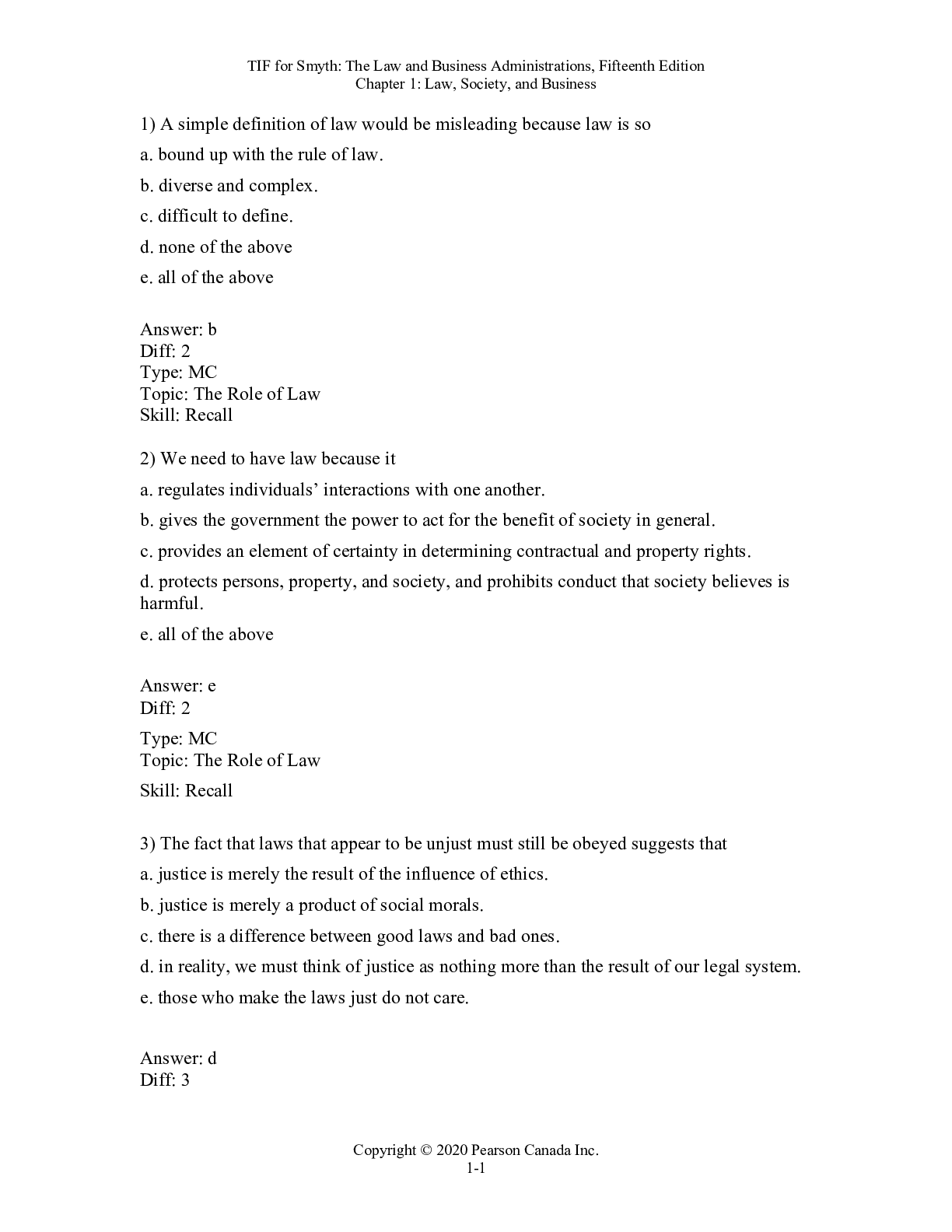
Reviews( 2 )

by lbgordon1823 · 2 weeks ago
Welcome by Test-Bank Lounge. 2 weeks ago

by Test-Bank Lounge · 2 weeks ago
Document information
Connected school, study & course
About the document
Uploaded On
Aug 28, 2022
Number of pages
673
Written in
Additional information
This document has been written for:
Uploaded
Aug 28, 2022
Downloads
1
Views
179

